|
|
|
| My Favourite Planet > English > People > Nike |
|
| |
Nike
Ancient Greek mythology, religion and art
Nike (Νίκη) was the Greek goddess and personification of victory in war and sport. Her Roman equivalent was Victoria.
She is thought by some scholars to have been a daemon who only later came to be considered as a goddess, a belief which reached its height in the Hellenistic period and continued by the Roman worship of her as Victoria.
As with other deities, she was at some point appended to the complicated divine genealogies, of which there are several versions. According to Hesiod, her father was the Titan Pallas, and her mother the nymph Styx (daughter of Okeanos and Tethys). Her sister was Bia (Force), and her brothers Kratos (Strength, Supremacy) and Zelos (Zeal, Rivalry). [1]
Styx and her children sided with Zeus in the great battle against the Titans, and afterwards lived with him on Mount Olympus. The battle, known as the Titanomachy, was depicted several times by Greek artists, notably on the frieze around the Great Altar of Zeus (early 2nd century BC) on the Pergamon Acropolis.
However, in the Homeric hymn to Ares it appears that she is being described as a daughter of the war god:
"Ares, exceeding in strength, chariot-rider, golden-helmed, doughty in heart, shield-bearer, Saviour of cities, harnessed in bronze, strong of arm, unwearying, mighty with the spear, O defence of Olympus, father of warlike Victory..." [2]
It may be significant that there are no known myths in which Nike is a main protagonist; she always plays a supporting role, for example as the chariot driver for Zeus. She was closely associated with both Zeus and Athena, and statues were made of these major deities accompanied by a diminutive and subordinate Nike.
Famously, the Athenian sculptor Pheidias made a colossal chryselephantine (gold and ivory) statue of Athena Parthenos holding Nike in her right hand for the Parthenon, and another of Zeus holding Nike for the Temple of Zeus in Olympia. The latter was named by Philo of Byzantium as one of the Seven Wonders of the World.
In the Sanctuary of Athena Polias Nikephoros (Athena of the City, Bringer of Victory) in Pergamon stood the Library of Pergamon which housed a statue of Athena Parthenos (circa 200-150 BC), based on Pheidias' original in Athens. Although the arms of the statue are missing, it is thought that this figure also held a Nike in her hand.
It is not clear what part Nike took in human victories, although one poet wrote: "Nike ... in gold-rich Olympus, you stand beside Zeus and judge the outcome of prowess for immortals and mortals." [3]
Usually in Greek myth and literature, other gods are shown helping or hindering combatants in battles and competitions: Hephaistos and Athena aided Achilles at Troy, Athena helped Perseus against the Gorgon Medusa, and Pan caused chaos among the Persian invaders at Marathon (see Athens Acropolis gallery page 5). Nike is usually depicted flying to deliver victory, often carrying the victor's laurel wreath (see photo below), a palm or a trophy. Like Hermes, she appears to be merely the messenger of Zeus and other gods.
Like Hermes too, she seems to be constantly busy and on the move. In the balustrade relief panels of the Temple of Athena Nike on the Athens Acropolis, she is shown busily rushing around to serve Athena.
It is no wonder that at some point she was given wings to help her with her hectic work schedule. According to an ancient commentator on Aristophanes' comedy Birds, the sculptor Archermos of Chios (mid 6th century BC) was the first to represent Nike with wings (see photos below). She became one of the winged deities, along with Hermes, Eros, Iris and Nemesis; Hypnos, Thanatos, the Gorgon Medusa and the hero Perseus are also often shown with wings in ancient Greek and Roman art.
However, Pausanias reported that the cult statue (xoanon) in the Temple of Athena Nike had no wings and the goddess was known as Nike Apteros (Νίκη Ἄπτερος, Wingless Victory). His explanation for this is that the Athenians deprived her of wings so that she could never leave them. [4]
It is unclear whether the statue and temple were dedicated to Nike or Athena as Nike (i.e. Nike assimilated by the Athena cult, and Athena assuming her role as the bringer of victory). If the temple was originally dedicated to Nike alone, the statue may have been a very ancient cult image (or a copy of one) predating depictions of the goddess with wings.
The Byzantine encyclopaedia, the Suda, had the following to say about Nike and her wings:
"Athena Nike: Lykourgos in the speech On the priestess mentions her. That the xoanon of Nike, wingless, holding a pomegranate in her right hand and a helmet in her left, was worshipped by the Athenians Heliodoros the Periegete has shown in the first book of his On the Acropolis.
Alternatively she stands allegorically for the notion that even winning is completely dependent on thought; for thought contributes to victory, but being thoughtless and impetuous while fighting leads to defeat.
When she has wings she symbolizes that aspect of the mind that is sharp and, so to speak, swift-winged; but when she is depicted without wings she represents that aspect of it that is peaceful and quiet and civil, that by which the things of the earth flourish, a boon of which the pomegranate in her right hand is a representation. Just as the helmet in her left is a representation of battle. Thus she has the same capability as Athena." [5]
Nike was depicted on many coins, vase paintings and reliefs. Most of the statues, or parts of statues, of the goddess which have so far been found are thought to have either been set up on columns as part of victory monuments, or were aktroteria which decorated the corners of temple roofs. |
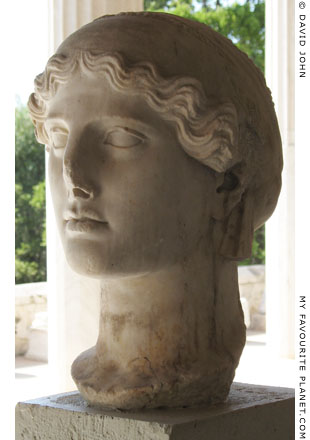
Marble head of the "Hertz head type"
(see below) from a statue of Nike.
2nd century AD. Found 31 July 1970, during
excavations by John McK. Camp II, in a well
(Deposit P 21:2) in the east colonnade of
the peristyle of a large late Roman complex
known as Roman House H, on the slope of
the Areopagus, south of the Athens Agora.
Pentelic marble. Height 41.7 cm.
Previously thought to be a copy of the
"Nike of Paionios" statue by Paionios in
Olympia, around 425-420 BC, but is perhaps
a copy of Nike from the Athena Parthenos
statue by Pheidias, around 450-430 BC.
Agora Museum, Athens. Inv. No. S 2354.
Among other ancient objects found in
the well was a marble head of Helios. |
| |
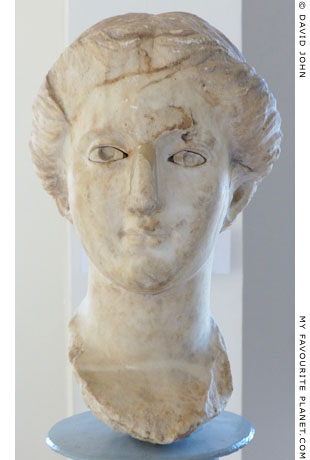
Marble head of a statue of Nike from the
Villa of Dionysos, Dion, Macedonia, Greece.
Copy of a 5th century BC original.
Dion Archaeological Museum. |
| |
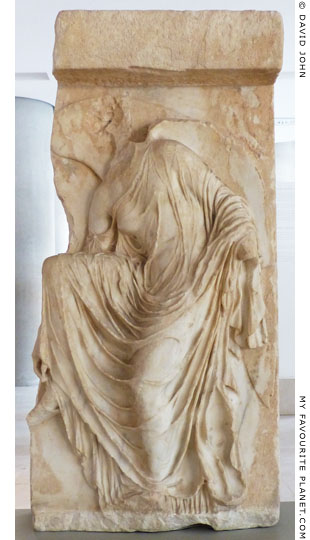
Marble relief of Nike adjusting her sandal,
known as «Σανδαλίζομἐνη» Νίκη
(the Sandalbinder), from the balustrade
(south parapet) around the bastion of
the Temple of Athena Nike on the
Athens Acropolis. Circa 410 BC.
Acropolis Museum, Athens.
Inv. No. Acr. 973. |
| |
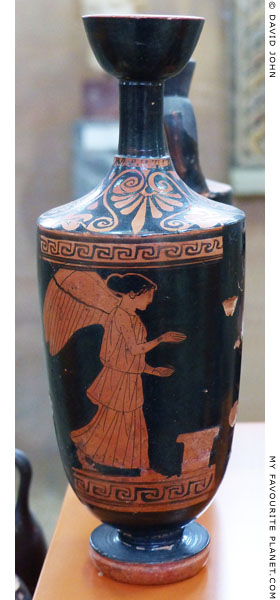
An Attic red-figure lekythos showing
Nike approaching an altar.
1st half of the 5th century BC.
Found in Corinth.
Corinth Archaeological Museum.
Inv. No. CP-39-4. |
| |
| |
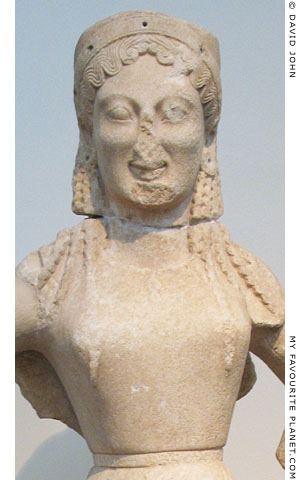
An Archaic statue of winged Nike.
Found at the Temple of Artemis, Delos
in 1877. The earliest known free-standing
statue of a Nike, probably made by
Archermos of Chios, around 550 BC.
Parian marble. Height 90 cm.
National Archaeological Museum,
Athens. Inv. No. 21. |
|
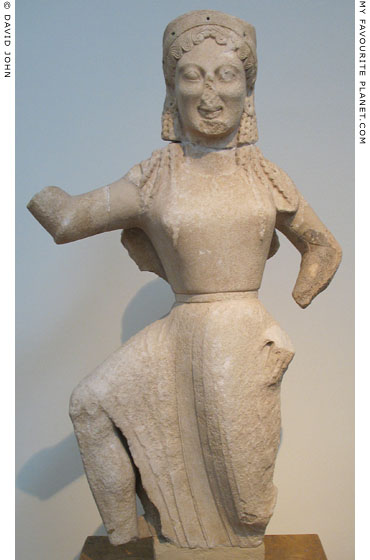 |
|
| |
The Scholia (commentary) of Aristophanes' play Birds mentions Archermos, artist, father of Bupalos and Athenis (or Athenidos), said to have been the first to represent Victory with wings:
"Only more recently have Nike and Eros acquired wings. For some say that it was Archennos [sic] the father of Boupalos and Athenis, others that it was Aglaophon the Thasian painter who made Nike winged, as Karystios of Pergamon relates."
There are varying translations of the Scholia. "Archennos" is thought to have been an error or misreading by those who copied the manuscripts.
See: John Williams White, The scholia on the Aves of Aristophanes, 574, pages 120 and 368. Ginn and Company, Boston and London, 1914. At the Internet Archive.
An inscribed statue base signed by Archermos and Mikkiades (perhaps Archermos' father), found in two fragments in 1880-1881 near to the findspot of the Nike, was thought to belong to the statue (see photo below), leading archaeologists to believe they had discovered the first winged Nike by Archermos. However, the base was later thought to have supported a sphinx. The fragmentary inscription has been reconstructed and translated in a number of ways.
Μ̣ικκι̣ά̣[δης τόδ’ ἄγ]α̣λ̣μ̣α καλὸν μ̣’ [ἀνέθηκεν καὶ υἱὸς]
Ἄ̣ρχερμ̣ος θ[υσ]ί̣η̣σιν ℎ(ε)κήβο[λον αὖθ’ ἱλάσασθαι]
οἱ Χῖοι Μέλ̣α̣ν̣ος πατρώιον ἄσ[τυ λιπόντες]
Inscription ID 9 (also SEG 19:510 and SEG 33:633).
One attempted translation:
"Farshooter [Apollo, receive this] fine figure [... worked by] the skills of Archermos, from the Chian Mikkiades ... the paternal city of Melas"
John Boardman, Greek art, page 91. Thames and Hudson, London, 2012 (4th edition).
The statue may have stood on a column as a votive offering or as an akroterion (roof ornament). The wing tips, parts of the lower arms and right hand, the lower left leg and both feet are missing. The lack of the bottom of the sculpture makes it impossible to be certain of the type of base to which it was attached.
Nike's head and upper torso are frontal, while her lower body and legs are shown in profile. She is shown with arms and legs bent in what appears to be a running or kneeling position, typical in Archaic depictions of flying deities and other mythical figures, for example the Gorgon Medusa (see also photos below). The pose is often referred to as the "Knielauf" (literally knee-run) schema, a phrase coined by German archaeologists.
She wears a peplos and chiton, with her lower right leg exposed. On her head she wears a stephane (crown) with holes for attaching metal ornaments. The holes in her ear lobes probably held earrings. Her hair has elaborately carved curls around the forehead, and falls in tresses over her shoulders and breasts. She has the "Archaic smile" seen on kouros and koure statues of the 7th - early 5th century BC (see examples on Samos gallery pages 4 and 5). |
|
|
| |

The inscribed statue base from Delos associated with the statue of winged Nike above.
According to the inscription, it was a base for a statue by Archemos of Chios.
Around 550 BC. Parian marble.
National Archaeological Museum, Athens. Inv. No. 21a.
Inscription ID 9 (also SEG 19:510 and SEG 33:633). |
| |
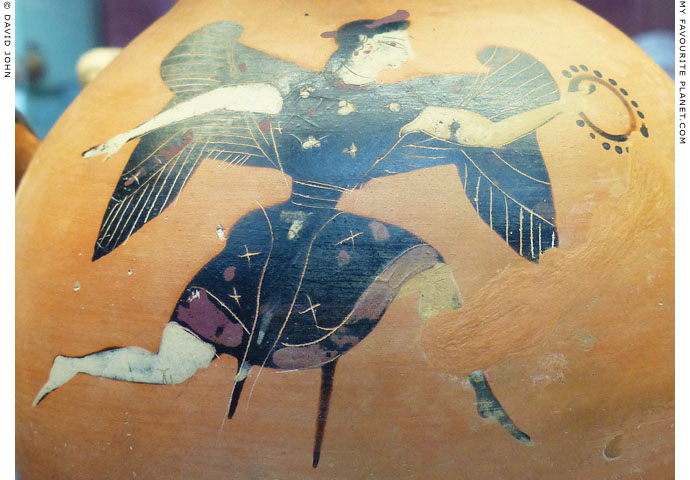
A running/flying four-winged Nike carrying a victor's wreath. 550-500 BC.
Detail of an Attic black-figure amphora made in or near Athens for the Cypriot market.
Found at Site E, tomb 78, Amathus (Ἀμαθοῦς), on the south coast of Cyprus. Amathus
was excavated November 1893 - March 1894 by A. H. Smith and John Myres, as part of
the Turner Bequest Excavations on Cyprus (1893-1896).
Height 24.7 cm, diameter (mouth) 10.2 cm.
Nike, wearing a flat band (taenia) on her head, a short tunic and fawn skin (nebris),
runs/flies to the right with outstretched arms, legs and four wings. The original report
on this amphora described the figure as a Boread, and a similar running figure on the
other side as a Harpy. [6] Both figures are incised and painted in the black-figure
technique on a red ground, with added white and purple paint.
British Museum. GR 1894,11-1.161. Acquired in 1894. |
| |
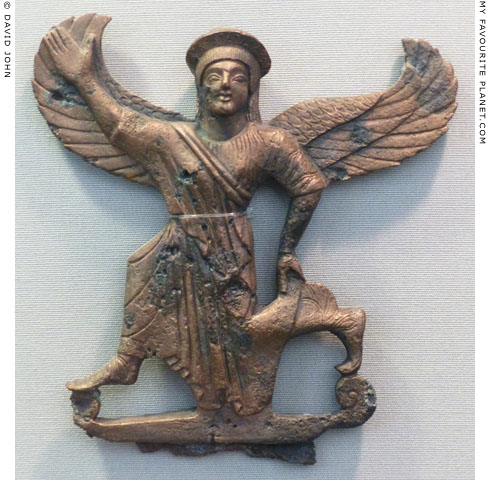
Archaic bronze plaque from the Athenian Acropolis, with a relief
of a winged Nike running or flying in the "Knielauf" position.
Probably a decoration of a bronze vessel. Height 15 cm.
National Archaeological Museum, Athens. Inv. No. 6477.
One of a number of similar bronze Nikes found in Athens. Others,
found at the Acropolis and now in the National Archaeological
Museum, Athens, include Inv. Nos. 6476, 6478 and 6480. |
| |
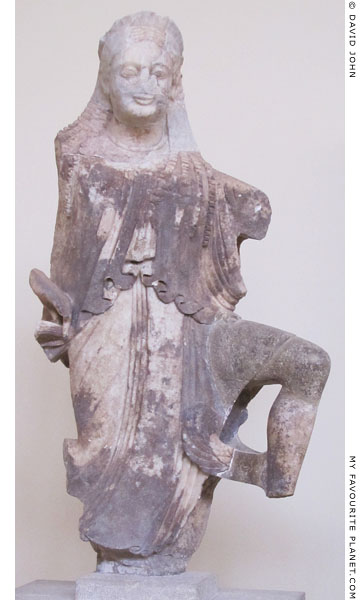 |
|
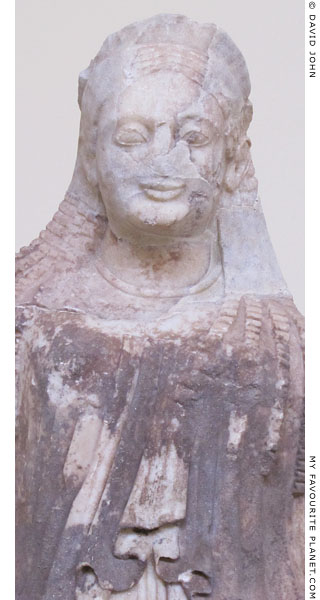 |
Archaic marble statue of winged Nike from the akroterion of the Archaic
temple of Apollo in Delphi. Marble, 515-505 BC. Height 113 cm. Found
during excavations around the temple and the Sacred Way in 1894 and 1895.
Nike is shown in the conventional running/flying position and has wings attached
to her lower left leg. It has been suggested that the figure may be by Antenor.
Delphi Archaeological Museum. Inv. No. 1872. |
|
| |
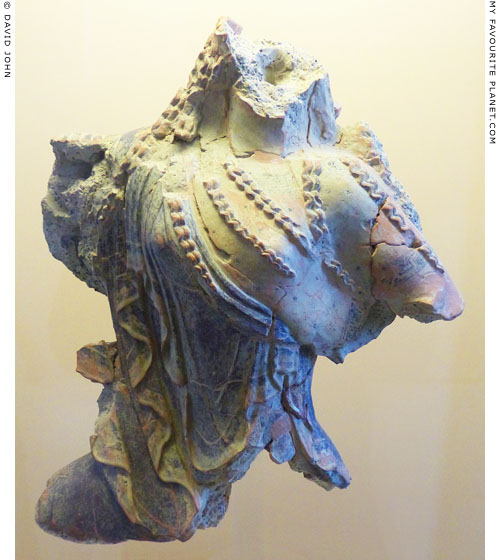
Fragmentary torso of a painted ceramic statue of winged Nike.
An akroterion of a treasury in Olympia, around 500-490 BC.
Olympia Archaeological Museum. Inv. No. T 304 - T 254.
Currently exhibited in the Museum of the History
of the Ancient Olympic Games, Olympia. No. 322. |
| |
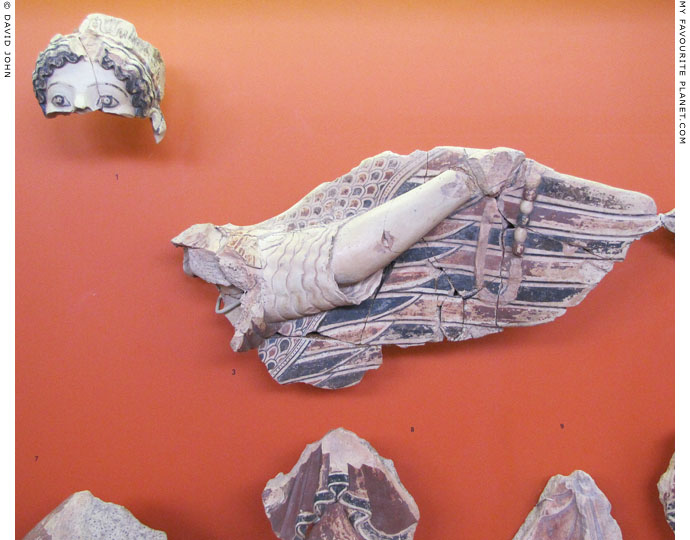
Fragments of a painted terracotta akroterion depicting winged Nike, from
the poros (limestone) temple of Athena Pronaia, Delphi, circa 500 BC.
Delphi Archaeological Museum, Greece. |
| |
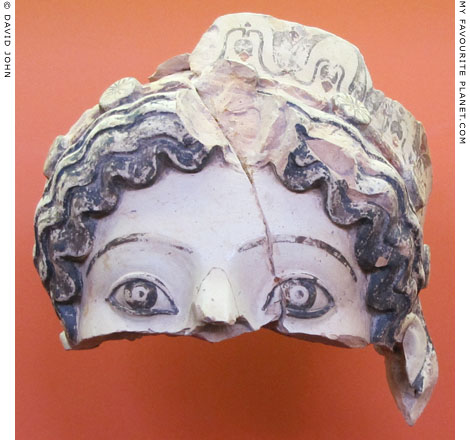
Fragment of the painted terracotta head of the Nike akroterion above.
Delphi Archaeological Museum, Greece. |
| |
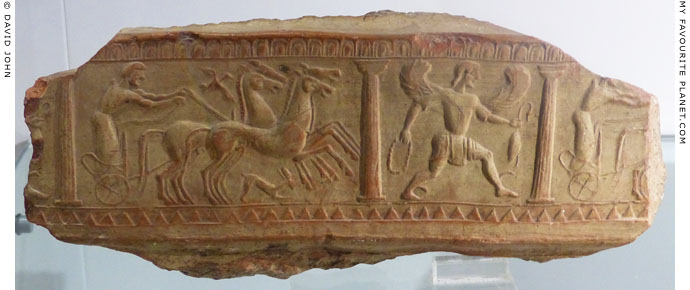
Stamped terracotta relief with a winged Nike carrying prizes for a chariot race.
From Akragas (Agrigento), Sicily, 6th - 5th century BC.
One of a number of rim fragments of locally made louteria (λουτήρια, large basins
on pedestals for ritual washing), with stamped reliefs depicting racing four-horse
chariots alternating with Nikes. The scenes are separated by Doric columns. The
louteria were also decorated with continuous friezes showing battles with Centaurs.
Agrigento Regional Archaeological Museum, Sicily. |
| |
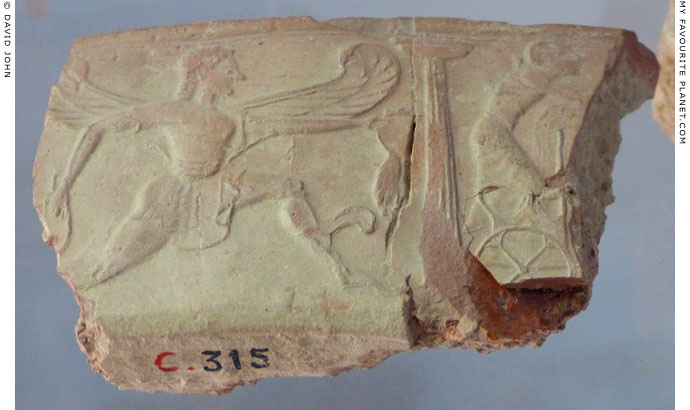
Another fragment of a louterion (λουτήριον) from Akragas showing a running/flying winged Nike.
Agrigento Regional Archaeological Museum, Sicily. Inv. No. C. 315. |
| |
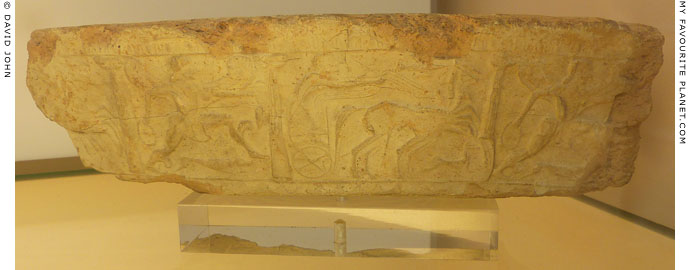
A similar fragment of a louterion from Selinous (today Selinunte), Sicily, about 520-500 BC.
British Museum. Inv. No. GR 1923.4-17.1. |
| |
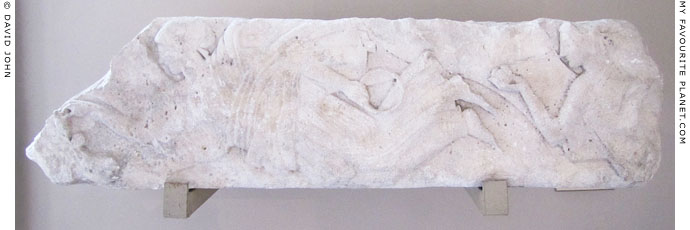
Lycian limestone block with a relief of Nike. Winged Nike, holding a victory weath in her left hand,
flies towards the left. Behind her a female figure holds a small round object (an offering of fruit?).
From Xanthus (Kinik), Lycia, Southern Turkey. Severe style, second quarter of the 5th century BC.
Istanbul Archaeological Museum. Inv. No. 5449 T. |
| |
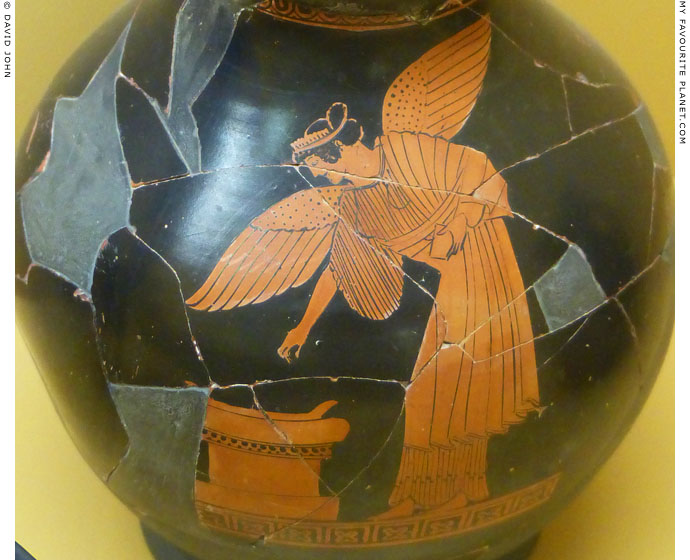
Detail of an Attic red-figure oichonoe showing Nike at an altar.
Made in Athens around 490-480 BC. Attributed to the Eucharides Painter
by Sir John Beazley. Fragments found on 9 and 11 May 1939 in a well in
the Ancient Agora of Athens.
Winged Nike, wearing a stephane (crown) and a himation over a long chiton,
bends over a flaming altar. With her right hand she sprinkles incense on the
altar from a box held in her left hand.
Agora Museum, Athens. Inv. No. P 15010.
See agora.ascsa.net/.... At the Agora Excavations website,
American School of Classical Studies at Athens (ASCSA). |
| |
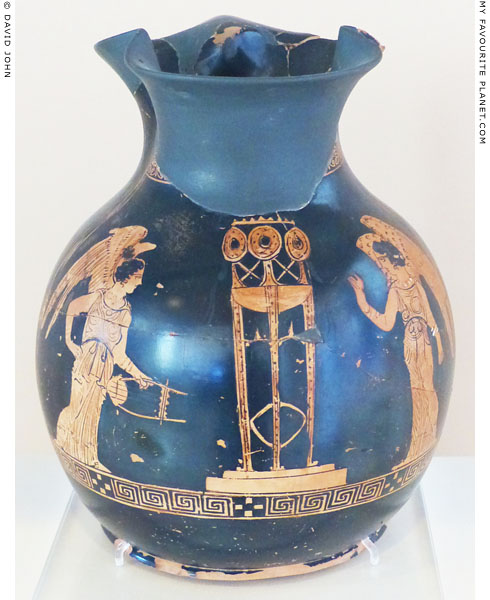
A fragmentary Attic red-figure chous (χοῦς, a squat, rounded form of oinochoe
wine jug with a trefoil mouth) showing two winged Nikai standing either side of
a large tripod on a two-stepped base. Each figure wears a girdled peplos with
a long overfold and bracelets on both arms. The Nike on the left holds a lyre in
her left hand. The wreath in the left hand of the Nike on the right and the fillets
hanging from each side of the tripod are difficult to see as the paint has faded.
Made in Athens around 420-410 BC. Painted in the manner of the Meidias Painter
according to Sir John Beazley. Found on 27 April 1954 in a well north of the
Nymphaeum in the Ancient Agora of Athens. Height 21.8 cm, diameter 17.9 cm.
Agora Museum, Athens. Inv. No. P 23896.
Currently exhibited in the Museum of the History
of the Ancient Olympic Games, Olympia. No. 336.
See:
agora.ascsa.net/.... At the Agora Excavations website,
American School of Classical Studies at Athens (ASCSA).
Beazley Archive Database, Vase No. 220593 |
| |
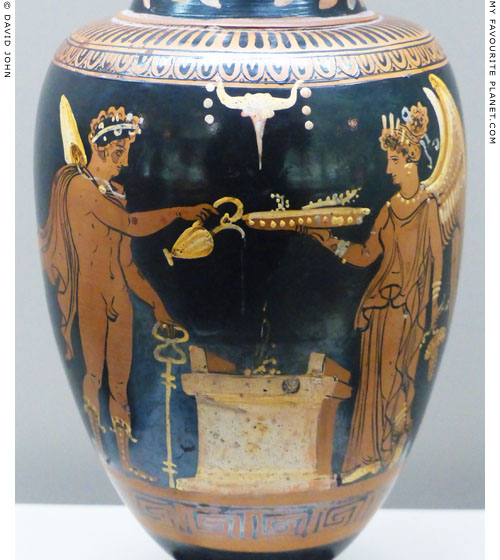
Detail of an Apulian red-figure, long-necked oinochoe (wine jug) depicting
Hermes and Nike making sacrifices and offerings of first fruits at a burning altar.
Mid 4th century BC.
Hermes wears a wreath, cloak and high sandals, with a petasos hanging from
his neck, and holds his kerykeion in his left hand. He stands to the left of a small
altar, notably shown in perspective, pouring a liquid (wine?) from a jug onto the
flames. Winged Nike, wearing a wreath and peplos, stands to the right of the altar
holding a bowl with offerings in her right hand, and a bunch of grapes in the left.
A garlanded boukranion (ox skull) hangs above them.
Civic Archaeological Museum, Milan. Inv. No. A 1997.01.255. From the Lagioia Collection. |
| |
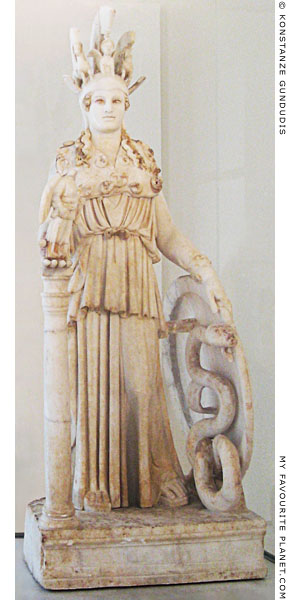 |
|
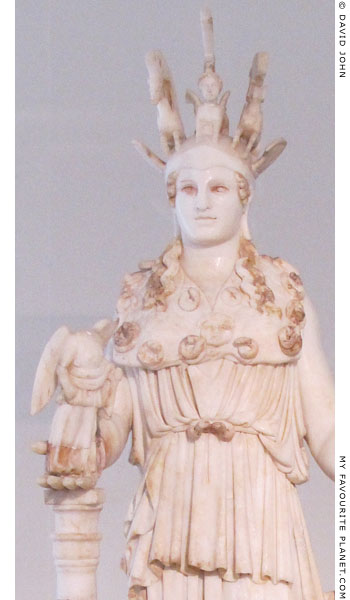 |
"The Varvakeion statuette" of Athena Parthenos holding Nike in her right hand.
Pentelic marble. 2nd - 3rd century AD, Roman period copy of the statue
by Pheidias, circa 447-439 BC, which stood in the Parthenon.
Found 18 December 1880 near the Varvakeion School,
in the Athens suburb of Psychiko.
National Archaeological Museum, Athens. Inv. No. 129.
photo, left: © Konstanze Gundudis |
|
| |
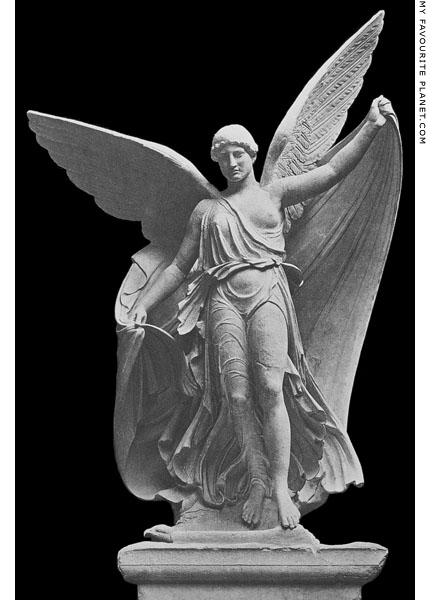 |
|
 |
Left: A full-size plaster reconstruction of the "Nike of Paionios" statue
from the sanctuary of Zeus at Olympia. Made by Oskar Rühm in 1894.
Abguss-Sammlung (Cast Collection), Dresden.
Right: A reconstruction of the statue on top of the 8.81 metre
high triangular pedestal of the victory monument. |
|
| |
The "Nike of Paionios" statue was made around 425-420 BC by Paionios of Mende, as part of a war victory monument for the people of Messene and Naupaktis in the Peloponnese, set up on the east side of the Temple of Zeus at Olympia. Various fragments of the 1.98 metre high statue of Parian marble, now reassembled in the Olympia Archaeological Museum (photo, right), were discovered 1875-1880 by German archaeologists around the east side of the temple. The complete figure, with the now missing wing tips, is thought to have been around 3 metres tall. Parts of the 8.81 metre high triangular column on which the sculpture stood were found at the same time, along with the dedicatory inscription for the monument which includes Paionios' signature and states that he also won the competition to sculpt the akroteria (roof decorations) for the Temple of Zeus:
"The Messenians and Naupaktians dedicated this to Olympian Zeus as a tithe from their enemies. Paionios of Mende made it and was victorious in making the akroteria for the temple."
Olympia 5, No. 259.
The Nike was mentioned by Pausanias:
"The Dorian Messenians who at one time received Naupaktos from the Athenians dedicated at Olympia the image of Nike on a pillar. It is the work of Paionios of Mende, made from spoils taken from the enemy, I think from the war with the Akarnanians and the people of Oiniadai.
The Messenians themselves say that their dedication resulted from their exploit on the island of Sphakteria along with the Athenians, and that they did not inscribe the name of the enemy through fear of the Spartans, whereas they had no fear at all of the people of Oiniadai and Akarnania."
Pausanias, Description of Greece, Book 5, chapter 26.
The first attempt to reconstruct the original appearance of the statue was made in 1883 by the Berlin sculptor Richard Grüttner (1854-1919), whose reduced-size plaster model showed Nike holding a palm branch, one of her attributes (see below, here and here), in her right hand and her himation (cloak) blowing free in the wind.
In 1894 the archaeologist Georg Treu (1843-1921), who had worked on the excavations at Olympia and from 1882 was the director of the antiquities and cast collections in Dresden (see the note on the Niobe page), worked with the Dresden sculptor Oskar Rühm (1854-1934) to make the above full-size plaster reconstruction of the statue based on Grüttner's 1883 work. It shows the winged Nike without attributes, holding the sides of her billowing himation with both hands. Since the front of the head and the face of the original staue were not found, they used as a model the "Hertz head type" of Nike from the collection of Henriette Hertz in Rome (see below), which Treu believed was copied from the Paionios Nike. Rühm also made a 1:10 scale model of the entire monument.
In 1896 Ernst Curtius commissioned Grüttner to make a full-size model, which was similar to Rühm's, and which was exhibited in the Altes Museum, Berlin. He made yet another scaled-down version (scale 1:5) in 1918, a plaster model with a bronzed surface, showing Nike holding a tainia (victor's headband), based on a theory of Curtius and his own examination of the fragments. A plaster model of his 1883 reconstruction of the entire monument is in the Abguss-Sammlung Antiker Plastik, Freie Universität, Berlin. Abgussform 1802. Height 230 cm, height of statue 58 cm.
Until the Second World War, two versions of the reconstruction of the monument, as 1:10 scale models by Rühm and Grüttner, were exhibited either side of Rühm's 1894 reconstruction of the statue, as centre pieces of the Olympia Saal, a room dedicated to casts of sculptures from the German excavations, in the Abguss-Sammlung on the second floor of the Albertinum. The Dresden museums had already acquired a cast of the original statue in 1876, and a cast of the head in 1880. These objects are not currently on display.
|
|
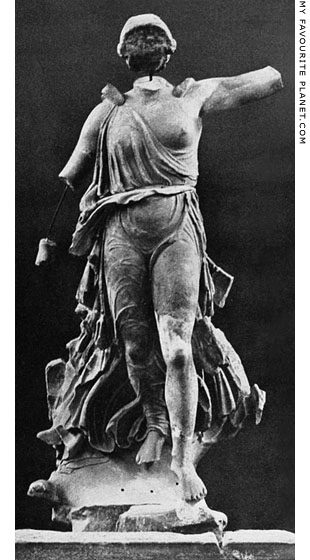
The surviving fragments of the
"Nike of Paionios" statue, reassembled
in the Olympia Archaeological Museum.
Inv. No. 46-48. |
|
See:
Gudrun Elsner, Kordelia Knoll (editors), Das Albertinum vor 100 Jahren - die Skulpturensammlung Georg Treus (The Albertinum 100 years ago - the sculpture collection of Georg Treu). Catalogue of the exhibition in the Albertinum, Dresden, 18 December 1994 - 12 March 1995. Staatliche Kunstsammlungen Dresden, 1994. Pages 15, 59, 60, and photos, catalogue Nos. 54-56 (pages 72-74).
Hans Rudolf Pomtow (1859-1925), Die Paionios-Nike in Delphi, in Jahrbuch des Kaiserlich Deutschen Archäologischen Instituts, Band 37, pages 55-112. Walter de Gruyter & Co., Berlin und Leipzig, 1922. At the Internet Archive.
Pomtow's illustrated article is primarily concerned with a tall triangular column in Delphi, similar to that of the "Nike of Paionios", inscribed with proxeny decrees of the Messenians and Naupaktians and believed to have been the base of a similar Nike statue.
See also information about other statues on tall columns in Athens and
Delphi in The Pedestal of Agrippa, Athens Acropolis gallery, page 8.
Image sources
Above left: Ernst Curtius, Friedrich Adler, Georg Treu, Olympia: die Ergebnisse der von dem Deutschen Reich veranstalteten Ausgrabung, Textband 3: Die Bildwerke in Stein und Thon, Abbildung 210. A. Asher & Co., Berlin, 1897. At Heidelberg University Digital Library.
Above right: Ernst Curtius, Friedrich Adler, Georg Treu, Olympia: die Ergebnisse der von dem Deutschen Reich veranstalteten Ausgrabung, Tafelband 3: Die Bildwerke in Stein und Thon, Tafel XLVIII. A. Asher & Co., Berlin, 1894. At Heidelberg University Digital Library.
Right: Richard Hamann, Olympische Kunst: Auswahl nach Aufnahmen des kunstgeschichtlichen Seminars mit einer Einleitung, Tafel 57. Verlag des Kunstgeschichtlichen Seminars der Universität, Marburg, 1923. At the Internet Archive. |
|
|
| |
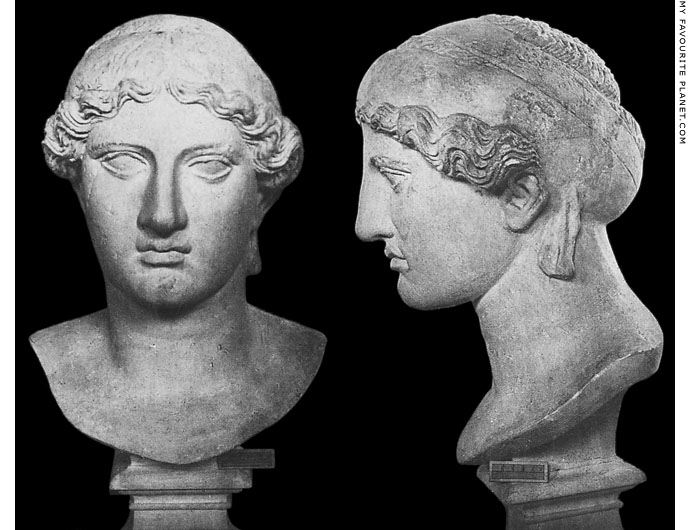
Plaster cast of a marble head of Nike of the "Hertz head type". Front and left side views.
The original, 2nd century AD. The nose and lower lip have been restored,
and the lower neck and bust are also modern additions. Height 33 cm.
Museo nazionale del Palazzo di Venezia, Rome. Inv. No. PV 3256.
From the collection of Henriette Hertz, Rome.
Image source: W. Amelung, Weiblicher Kopf, Tafel VII (see below). |
| |
The "Hertz head type" (German, Hertzscher Kopf) is named after this example, formerly in the collection of the German-born philanthropist, author and art collector Henriette Hertz (1847-1913), in the Palazzo Zuccari, Rome. Purchased on the Roman art market, it was bequeathed by "Fräulein Hertz" to the city of Rome, and is now in the Palazzo Venezia.
The other examples of the type are the head in the Agora Museum, Athens (see photo above), and an unrestored herm bust in the Chiaramonti Museum, Vatican Museums. Inv. No. 1589. The heads of this type were previously thought to be copies of the "Nike of Paionios"statue (see above) made by Paionios of Mende in Olympia around 425-420 BC, but according to a more recent theory may be copies of the Nike figure from the Athena Parthenos by Pheidias, around 450-430 BC.
The front of the head and face of the "Nike of Paionios" statue are missing (see photo, right), but details, such as the hair and the fillet (headband), of the Hertz type heads were compared with it and considered close enough to associate them with Paionios. The idea was proposed by the archaeologist Walther Amelung, who was the first to publish information about the head in the Hertz collection in 1894, and the theory was expanded upon a few years later by Georg Treu, who took part in excavations at Olympia.
See: Walther Amelung (1865-1927), Weiblicher Kopf, in Mitteilungen des Deutschen Archäologischen Instituts, Römische Abteilung, Band 9, pages 162-169, Tafel VII. Verlag von Loescher & Co., Rome, 1894. At DigiZeitschriften.
Georg Treu, Nike des Paionios, in Ernst Curtius, Friedrich Adler, Georg Treu, Olympia: die Ergebnisse der von dem Deutschen Reich veranstalteten Ausgrabung, Textband 3: Die Bildwerke in Stein und Thon, pages 182-193, Tafeln XLVI-XLVIII, Abbildungen 210-224. A. Asher & Co., Berlin, 1897. At Heidelberg University Digital Library.
This theory was questioned by some scholars, including Tonio Hölscher (Die Nike der Messenier und Naupaktier in Olympia, in Jahrbuch des Deutschen Archäologischen Instituts 89, 1974, pages 70-111, particularly page 74). In the early 1980s Evelyn Byrd Harrison (1920-2012), working at the Athenian Agora for the American School of Classical Studies at Athens (ASCSA), claimed that the heads were copies of the Nike from the Athena Parthenos statue by Pheidias, on the basis of style. Since the appearance of this statue is known only from small Roman period copies such as the "Varvakeion statuette" (see above), on which the head of Nike is missing, and the "Lenormant Athena" statuette, on which the Nike figure is missing altogether, the attribution to Pheidias remains just as conjectural as the Paionios connection.
See: Evelyn B. Harrison, Two Pheidian heads: Nike and Amazon, in Donna Kurtz and Brian A. Sparkes (editors), The eye of Greece: Studies in the art of Athens, pages 53-63, plates 14-16. Cambridge University Press, 1982. |
|
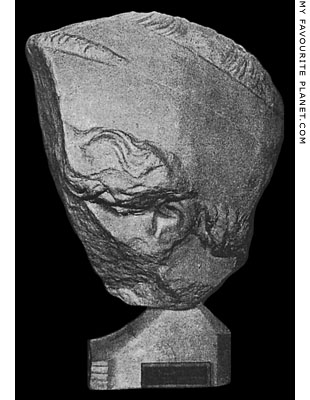
The left side of the surviving fragment of
the head of the "Nike of Paionios" statue.
Found 3rd November 1879.
Source: W. Amelung, Weiblicher Kopf, Fig. 1. |
|
 |
|
|
| |
| |
 |
| |
 |
| |
 |
| |
 |
| |
 |
| |
 |
| |
George Alvanos
rooms in
Kavala's historic Panagia District
Anthemiou 35,
Kavala, Greece
kavalarooms.gr
|
| |
Olive Garden Restaurant
Kastellorizo,
Greece
+30 22460 49 109
kastellorizo.de
|
| |
Papoutsis
Travel Agency
Kastellorizo,
Greece
+30 22460 49 286
greeklodgings.gr
|
| |
| |
| |
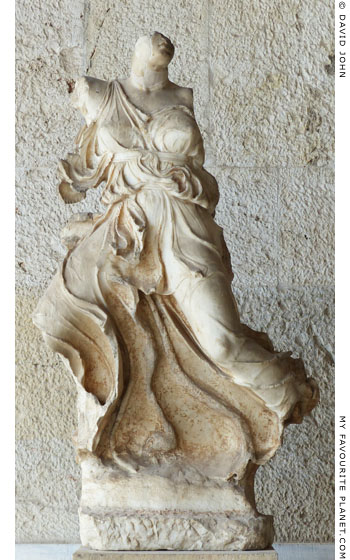
A fragmentary marble akroterion statue of
winged Nike flying to the right, from the Ancient
Agora of Athens. Attributed to Kallimachos.
Circa 400 BC. Pentelic marble.
Height with plinth 129 cm.
Discovered at the site of the Stoa of Zeus
Eleutherios [7] in the Athens Agora on 21 March
1933 by archaeologists of the American School
of Classical Studies in Athens (ASCSA).
Part of the head, arms and legs are missing.
Fragments of the drapery were also found.
The back side is less finished than the front.
Agora Museum, Athens. Inv. No. S 312. |
|
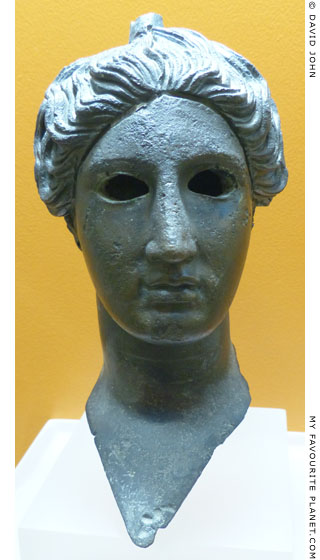
Bronze head of a statue of winged Nike
from the Ancient Agora, Athens.
420-415 BC. Probably one of the series of
"Golden Nikai" made in the time of Perikles.
Agora Museum, Athens. Inv. No. B 30. |
|
| |
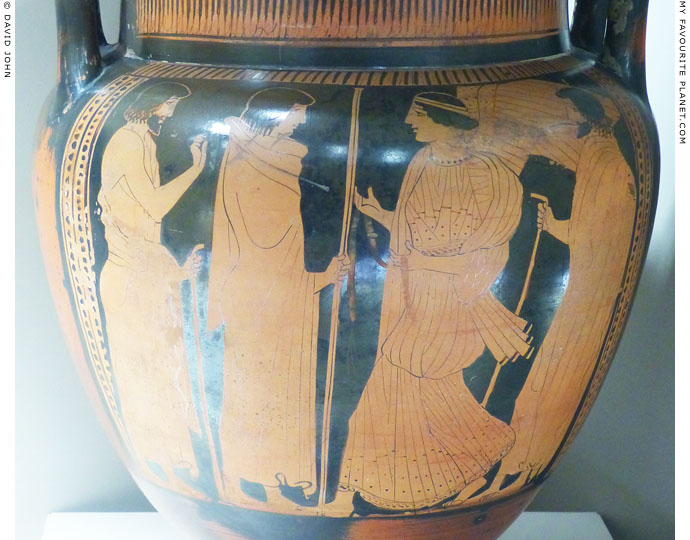
Detail of an Attic red-figure column-krater showing Nike
awarding a prize of a headband to a young athlete.
Made in Athens around 450-400 BC.
Winged Nike, approaching from the right, carries the headband in both hands.
The victorious athlete, wearing a himation (cloak) and holding two javelins, faces her.
They are flanked by two bearded men with sticks, perhaps paidotribai (trainers).
Civic Archaeological Museum, Milan. Inv. No. A 2000.04.16. From the Vitali Collection. |
| |
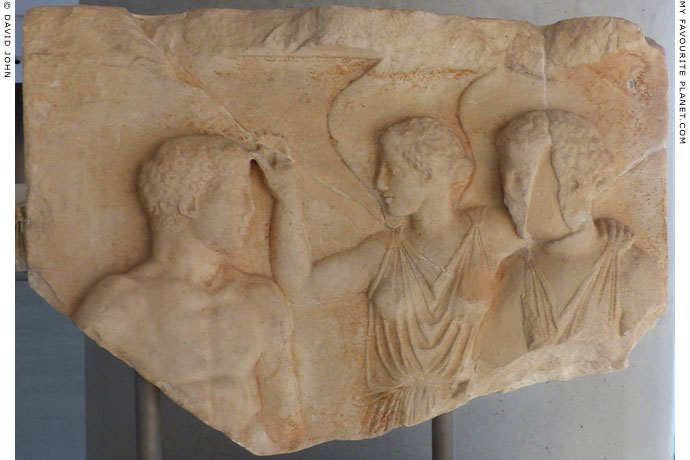
A dedicatory relief from the Athens Acropolis of a winged Nike crowning Herakles
or a victorious athlete, and with her left hand on Athena's shoulder. 420-410 BC.
Acropolis Museum, Athens. Inv. No. Acr. 1329.
See also a 2nd century AD clay disc depicting Nike crowning Hermes. |
| |
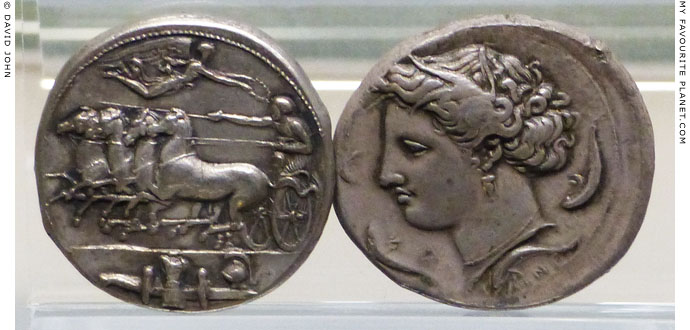
Two examples of silver dekadrachms from Syracuse (Συράκουσαι, Syrakousai; Italian,
Siracusa), Sicily, minted around 400-370 BC by the tyrant Dionysios I of Syracuse
(Διονύσιος ὁ Πρεσβύτερος, Dionysios the Elder, circa 432-367 BC, ruled 405-367 BC).
Civic Archaeological Museum, Milan.
|
On the right, the obverse side shows the head of the Nymph Arethousa (Ἀρέθουσα, the Waterer), the symbol of Syracuse, wearing a pendant earring and necklace, and surrounded by four swimming dolphins. On the left, the reverse side depicts winged Nike flying to bring a victor's wreath to a man driving a racing chariot drawn by four horses (a quadriga; Greek, τέθριππον, tethrippon). In the lower register (exergue) armour trophies, greaves, a cuirass, and an Attic helmet, stand on a ship's prow (some scholars have seen the long form behind the armour as a spear).
The chariot scene may depict games held during the Syracusan Assinaria festival commemorating their victory over the Athenian expeditionary force at the river Assinaros (Ἀσσίναρος) in 413 BC [8]. It has also been suggested that armour, perhaps captured from the Athenians, was offered as prizes (labelled αθλα, athla, on some of the coins). According to another theory, the coins may be connected with Dionysios’ victory over the Carthaginians in 405 BC.
This type of high denomination coin is thought to have been minted to pay mercenaries, and to have been in circulation for a short time, after which most were melted down. Some of the coins were signed by the die engravers Kimon (Κίμων), who is thought to be the creator of the type, and Euainetos (Ευαινετος). They are considered to have produced the most beautiful Greek coins and to have influenced coin designers around the Greek world. The coin on the right above is signed EY-AINE, the signature of Euainetos, below Arethousa's head. Like other surviving dekadrachms of this type signed by him, the heads side is badly centred, with much of the top-left of the design missing.
Many modern sources describe the obverse (front or recto, right) side of these coins as the reverse (back or verso, avers, left), and vice versa. Usually the obverse of a coin is the "heads" side which often bears the identifying symbol of the authority that strikes the currency, and the name of the issuing state and/or ruler. Many of the coins of this type include the inscription ΣΥΡΑΚΟΣΙΩΝ (Syrakosion), sometimes abbreviated, on the side showing the head of the city's symbol Arethousa. However, it has been argued that the earliest Syracusan coins had designs (including chariots) on one side only, which was therefore de facto the obverse (some show a small head, thought to depict Arethousa, in an incuse square on the other side). The Nike, charioteer and armour may well be seen as the essential symbols of the city authority, even though inscriptions rarely appeared on this side. It has also been claimed that the heads side only became the obverse around 317 BC, during the rule of the Syracusan King Agathocles (Ἀγαθοκλῆς, tyrant of Syracuse 317-289 BC, and king of Sicily 304-289 BC).
Left: weight 41.05 gram; diameter 35 mm; 8. Brera, No. 5637.
Right: weight 42.04 gram; diameter 36 mm; 7. Brera, No. 5638. [9]
Read more about these coins in Big Money at The Cheshire Cat Blog. |
|
| |
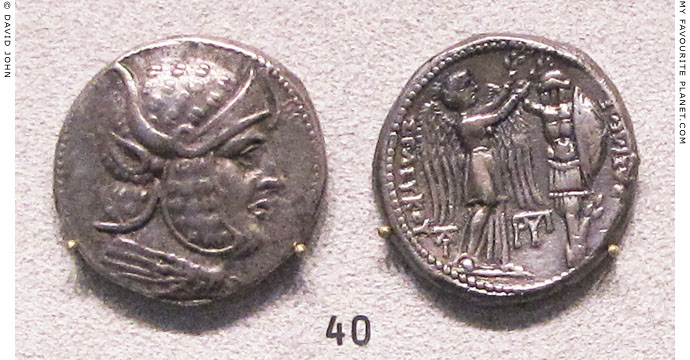
Winged Nike on a silver tetradrachm coin of Seleucus I, minted at Susa, Persia, after 300 BC.
Nike places a victory wreath on a panoply set up on a tree as a military trophy.
Altes Museum, Berlin. |
| |
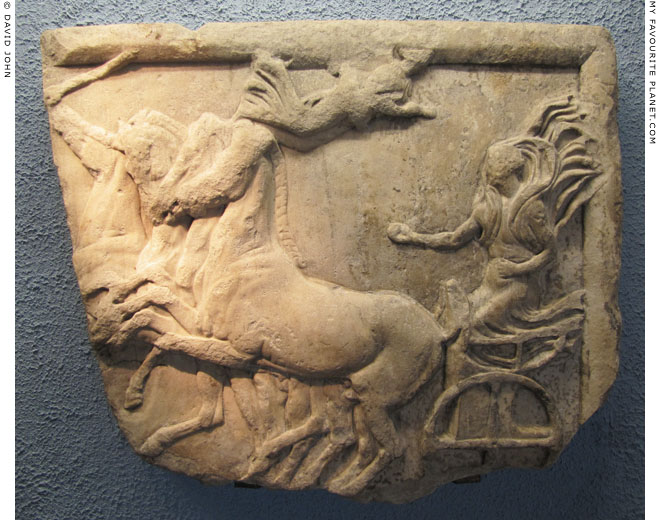
The upper right corner of a marble votive relief dedicated to Athena. Winged Nike flies
down to place a laurel wreath on a charioteer driving a four-horse chariot (quadriga;
Greek, τέθριππον, tethrippon), perhaps a victor in the Panathenaic Games.
Made in Athens around 425 BC. From Athens.
A fragment of the lower left side of the relief in the British School
at Athens shows the lower half of a standing figure of Athena,
depicted at a much larger scale than the charioteer.
British Museum. Inv. No. GR 1816.6-10.197 (Sculpture 814). Elgin Collection. |
| |
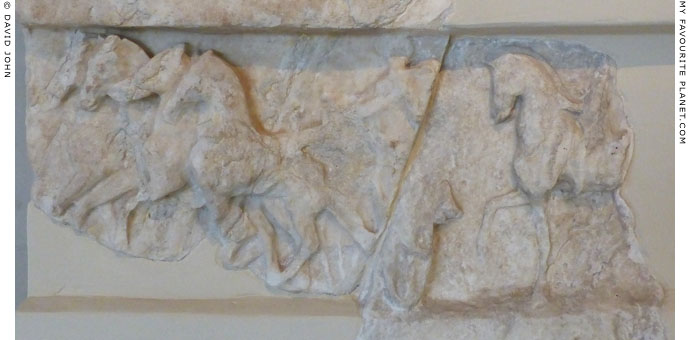
Relief showing Nike driving a four-horse chariot.
Detail of a fragment of an Athenian decree for Arybbas, king of the Molossoi of Epirus.
From the Athenian Acropolis. 343/342 BC.
The decree granted hospitality and privileges to Arybbas, son of Alketas, after he was
dethroned by Philip II of Macedonia and fled to Athens. The relief and laurel wreaths on the
marble stele are reminders of Arybbas' equestrian victories at the Olympian and Pythian games.
Acropolis Museum, Athens. Inv. No. EM 1 3291 (From the Athens Epigraphical Museum). |
| |
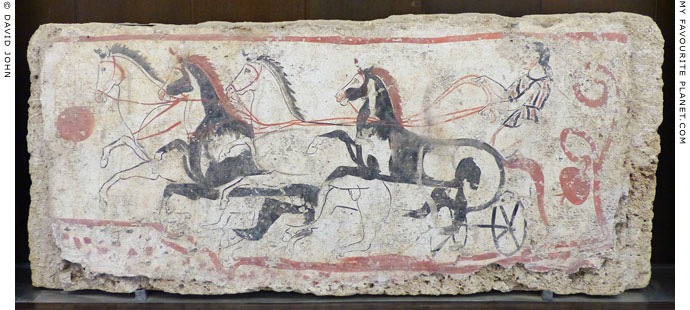
Fresco showing Nike driving a four-horse chariot.
Northern slab from Tomb 84 (350-340 BC), Andriuolo, Paestum (ancient Poseidonia), Italy.
National Archaeological Museum of Paestum. |
| |
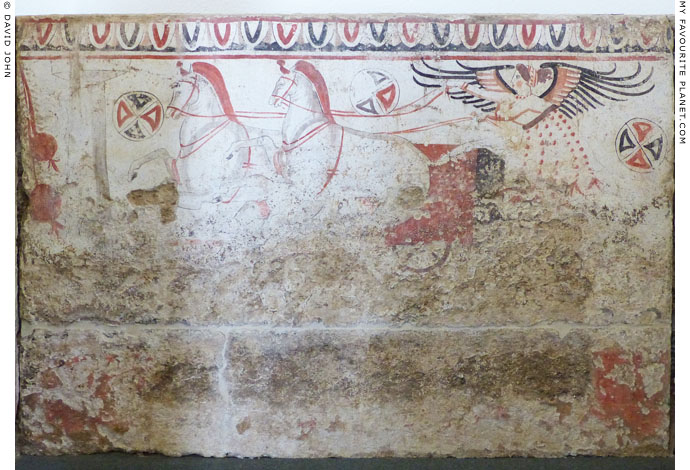
Fresco showing winged Nike driving a two-horse chariot on a race-course.
Northern slab from Tomb 86 (330-320 BC), Andriuolo, Paestum.
National Archaeological Museum of Paestum. |
| |
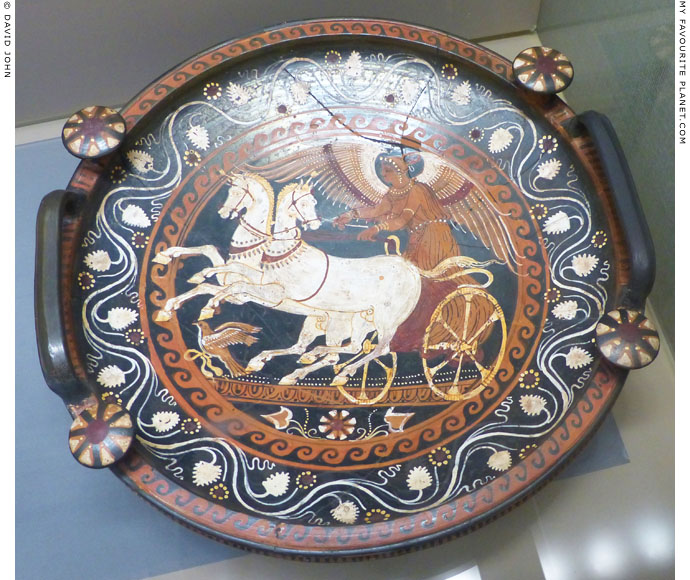
Winged Nike driving a chariot drawn by two white stallions on the inner
roundel of an Apulian red-figure phiale (libation bowl) with white and yellow
over-painting. On the left, a flying bird carries a victor's headband in its talons.
325-300 BC.
The lively drawing and dynamic composition are heightened by the use of strongly
contrasting tones and colours. The figures break out of the inner frame of waves.
Civic Archaeological Museum, Milan. Inv. No. A 2000.01.05. |
| |
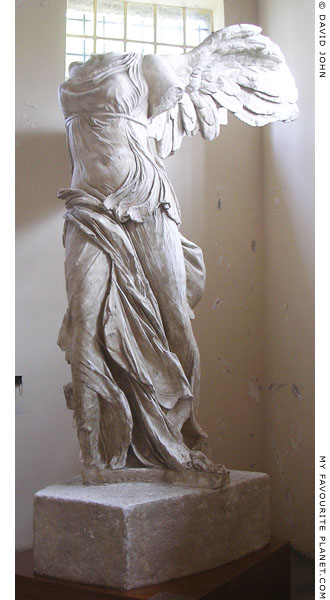
A plaster copy of the "Winged Victory of Samothrace"
in Samothraki Archaeological Museum.
|
The statue of the Winged Victory of Samothrace (Νίκη της Σαμοθράκης, Niki tis Samothrakis) depicted Nike standing or landing on the prow of a warship (see photo below). It is thought to have been made by Pythokritos of Rhodes, circa 220-185 BC, as part of a monument to commemorate a victory in a naval battle, and stood above the cavea (audience seating area) of the theatre in the Sanctuary of the Great Gods.
The original statue, now in the Louvre, Paris (Inv. No. MA 2369), was made of Parian marble, and the ship's prow and the base (not included with the copy on Samothraki) are of gray marble from Lartos, Rhodes (lithos lartios). There is also a copy in Istanbul Archaeological Museum (see below).
This type of statue showing winged Nike landing majestically, with the drapery of her himation (cloak) and peplos (belted by a knotted cord just below the breasts) which cling to the body and legs due to wind and swift movement, can be traced back to the Classical "Nike of Paionios" statue (see above), made in Olympia by Paionios of Mende around 425-420 BC. See also the "Chiaramonti Niobid". |
|
| |
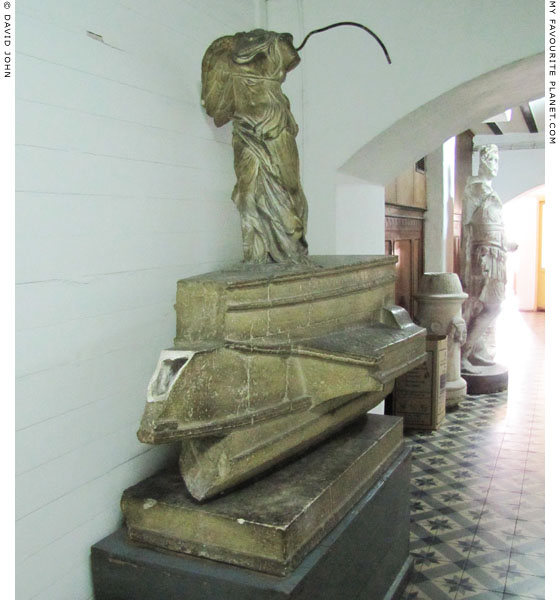
A copy of the "Winged Victory of Samothrace" statue in Istanbul Archaeological Museum.
|
The Istanbul copy, looking grubby and in much need of restoration, stands with other unlabelled and forgotten sculptures and copies in a dark corridor of a side building leading to the toilets. It is smaller than the original, but unlike the copy in Samothraki it stands on the ship's prow now to be seen in the Louvre.
I have not yet found a reference to this copy, and can only assume it was a compensatory gift from the French. It may be understandable that its restoration is not a top priority for Istanbul's enormous museum, but it is yet another case of a neglected artefact for which other museum directors would give their right arm.
Several other replicas of the statue have been made for museums, galleries, universities and other buildings and spaces around the world, including one outside Caesar's Palace casino in Las Vegas, where perhaps Fortuna (Tyche) may have been more appropriate. "Everyone's a winner" or "Luck be a lady tonight"? |
|
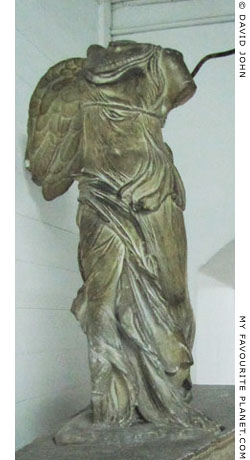
Winged Nike of Samothrace
in Istanbul, March 2010. |
|
| |
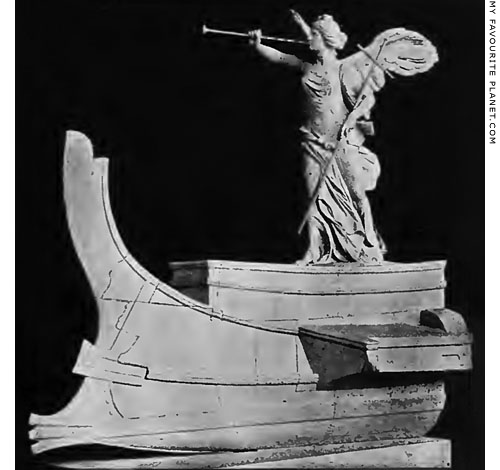
A reconstruction of the Nike of Samothraki by Benndorf and Zumbusch.
Photo by Frankenstein. Source: Emanuel Loewy, Die griechische Plastik , Volume 2, Tafeln
(plates), Abbildung 209c. Klinkhardt und Biermann, Leipzig, 1911. At the Internet Archive. |
| |
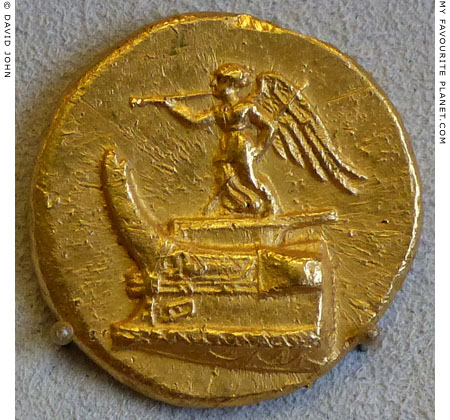
A winged Nike blowing a trumpet on the prow of a warship.
|
A gold stater minted by Demetrios Poliorketes to commemorate his naval victory over Ptolemy. Salamis, Cyprus, circa 300-295 BC.
Bode Museum, Berlin.
The similarity of the images of Nike on such coins to the statue of the Winged Victory of Samothrace have led scholars to search for a connection between them. |
|
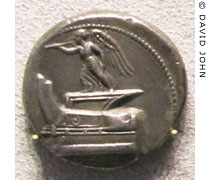
Tetradrachm of Demetrios
Poliorketes. Salamis, Cyprus,
circa 300-295 BC. A winged
Nike blowing a trumpet on
the prow of a warship.
Altes Museum, Berlin. |
|
| |
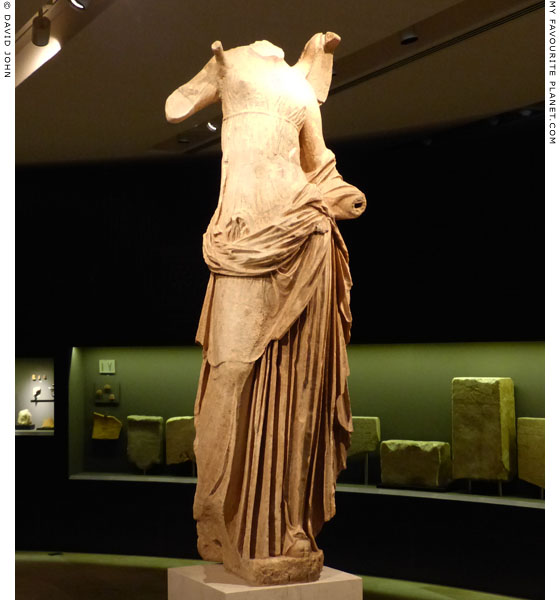
Winged Nike Akroterion from the Hieron, in the the Sanctuary of the Great Gods, Samothraki.
Proconnesian marble, 120-100 BC.
Samothraki Archaeological Museum, Paleopolis, Samothraki.
|
This was the third Nike statue found at the Sanctuary of the Great Gods (the first was the "Winged Victory of Samothrace", see above). It was discovered by American archaeologists of New York University in 1949, carefully buried 9 metres north of the southwestern corner of the Hieron.
The winged figure wears a chiton, with a himation draped over the lower body, and a sandal on her left foot. Her right arm was raised, and in her left hand she may have held a phiale (libation bowl).
The statue has often been described as being made of Parian marble. However, recent analysis has proved that the marble came from the island of Proconnesos (today Marmara, Turkey). It is thought that the statue was damaged in the first century BC and replaced by the Nike statue now in the Kunsthistorisches Museum, Vienna.
Photo taken at the exhibition "Samothrace, the island of the mysteries of the Great Gods",
Acropolis Museum, Athens, 20 June 2015 - 10 January 2016. |
|
| |
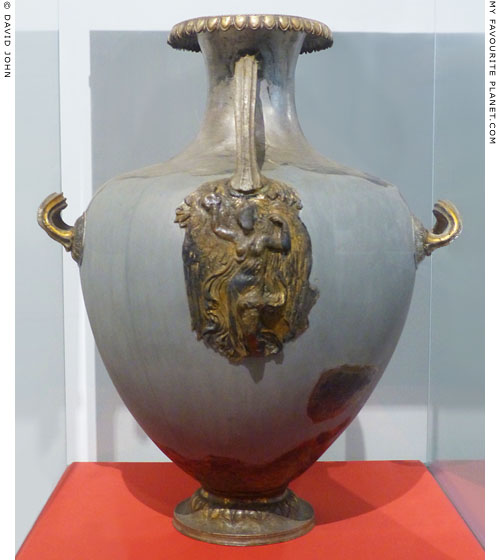 |
|
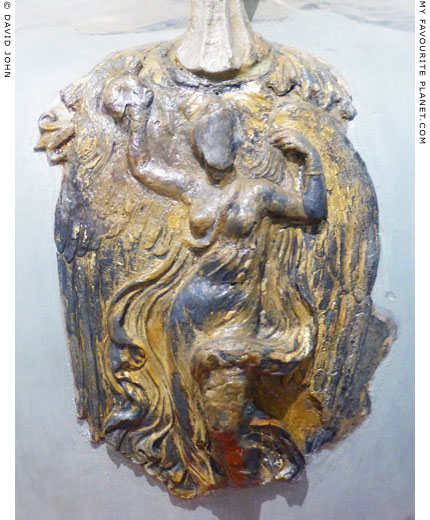 |
A relief of a Winged Nike as an attachment below the vertical handle
of a silver hydria (ὑδρία, three-handled water-carrying vessel).
4th century BC. From Amphipolis, Macedonia. Reconstructed from fragments.
Amphipolis Archaeological Museum. |
|
| |
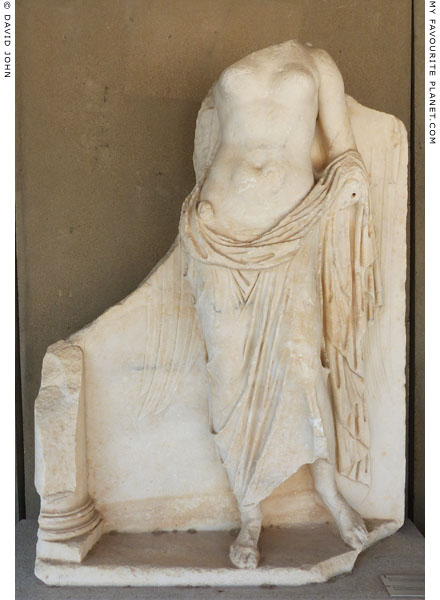
A marble high relief of a winged Nike standing
next to a trophy, perhaps a dedication.
From Thespiai, Boeotia, central Greece. Roman period.
Courtyard of Thebes Archaeological Museum. |
| |
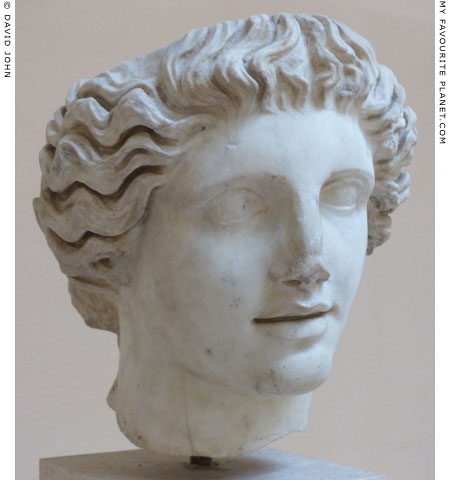
Marble head of a statue of Victoria from Ostia, the port of Rome.
Julio-Claudian era, 1st century AD.
Ostia Archaeological Museum. Inv. No. 1234. |
| |
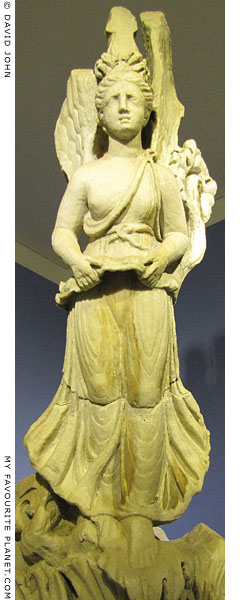
Statue of winged Nike from
an akroterion (roof decoration)
in the Pergamon Asclepieion.
Roman period, 2nd century AD.
Bergama Archaeological Museum,
Turkey. |
|
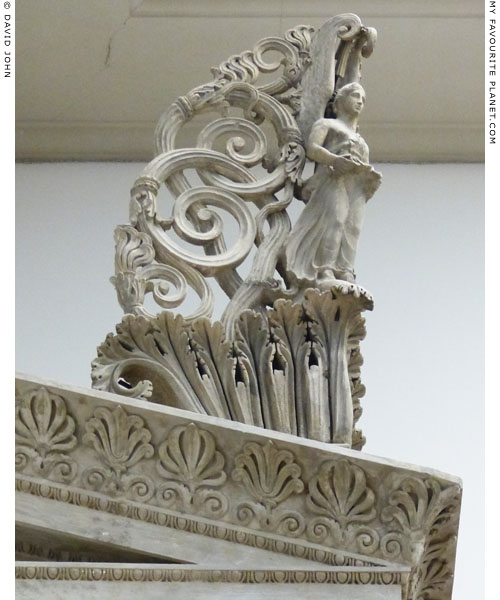
Winged Nike among plant forms on a marble akroterion
from the Temple of Trajan, Pergamon. 115-130 AD.
Pergamon Museum, Berlin. |
|
| |
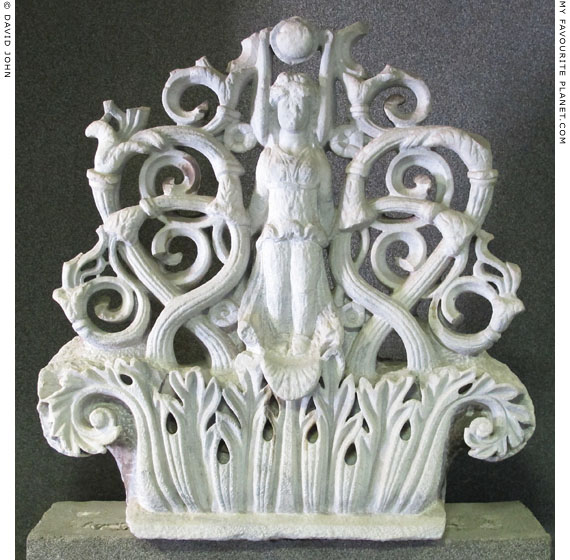
Winged Nike among plant forms on a marble
akroterion from the Pergamon Asclepieion.
Roman period.
Bergama Archaeological Museum, Turkey. |
| |
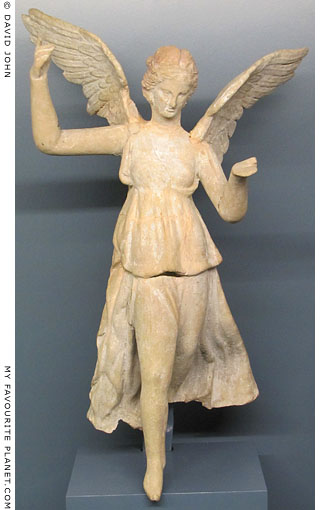
Terracotta statuette of winged Nike flying.
From Myrina, near Pergamon. 200-150 BC.
Antikensammlung, State Museums Berlin (SMB).
Inv. No. TC 8192. Purchased in Myrina
by the collector Alfred J. Lawson in 1888. |
|
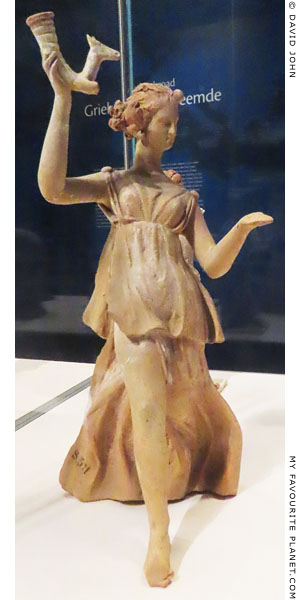
Terracotta statuette of Nike holding
a rhyton (drinking horn). From Myrina. 220-200 BC.
Rijksmuseum van Oudheden, Leiden. |
|
| |
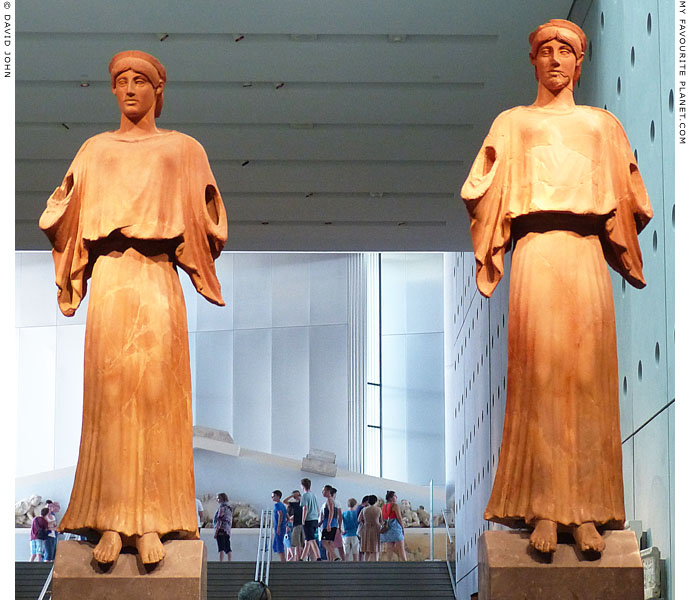
Two identical terracotta Nikes (or Nikai) found on the South Slope of the Acropolis.
Originally they had wings are depicted flying or landing, possibly on the building
on which they may have served as akroteria (roof ornaments).
Roman period, 1st - 3rd century AD.
Acropolis Museum, Athens. Inv. Nos. Acr. 6476 and Acr. 6476a. |
| |
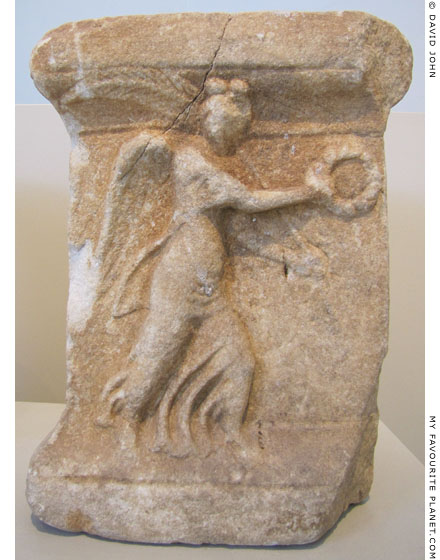
Small altar with a relief of a winged Nike carrying a wreath
and a palm branch. Provenance unknown. 2nd century AD.
Thasos Archaeological Museum. |
|
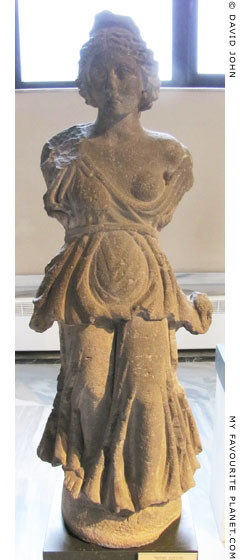
Basalt statue of Nike from Der'a,
Hauran, southern Syria. Roman
period, late 2nd century AD.
Istanbul Archaeological Museum.
Inv. No. 2408 T. Cat. Mendel 1399. |
|
| |
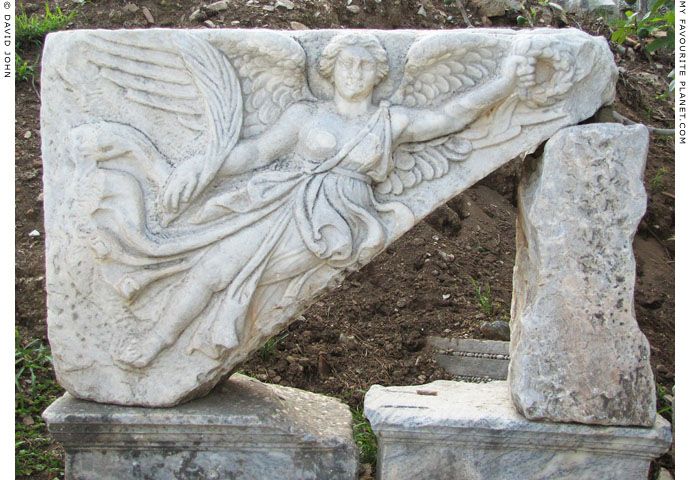
A marble relief of winged Nike from the "Herakles Gate" on Kuretes Street, Ephesus.
Ephesus archaeological site, Turkey.
|
| Roman Imperial period, 1st - 2nd century AD. It decorated one of the spandrels of the arch over the "Herakles Gate", and is thought to have been matched by a mirror image Nike relief on the opposite spandrel. The gate was built in the 4th century AD with materials from another monument. In her left hand Nike holds out a laurel wreath to crown a victor in war or sport, and in her right hand she carries a palm branch. |
|
|
| |
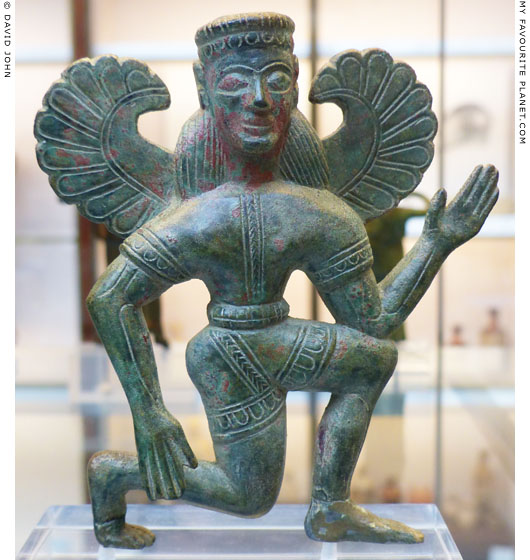
A running/flying winged goddess in the "Knielauf"
position, as a bronze attachment for a vessel.
Made in southern Italy, perhaps in Taranto, around 570 BC.
British Museum. GR 1867.5-8.767 (Bronze 495).
Blacas Collection. |
| |
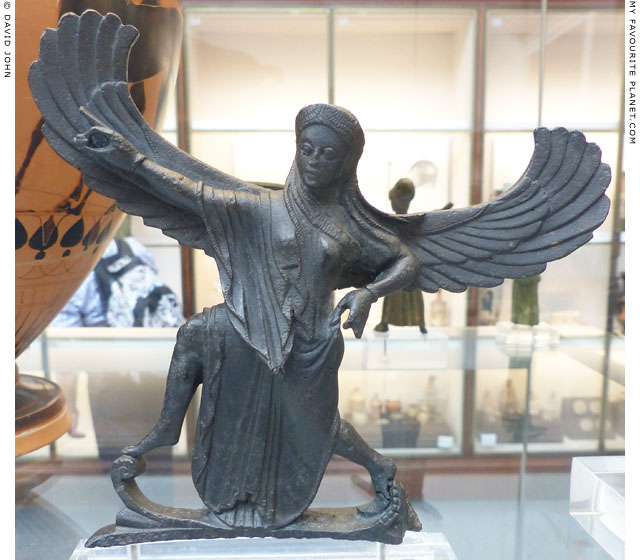
A running/flying winged goddess as a bronze attachment for a vessel.
Made in southern Italy, perhaps in Taranto, around 500 BC.
British Museum. GR 1824.4-97.21 (Bronze 491).
Bequeathed by R. Payne Knight. |
| |
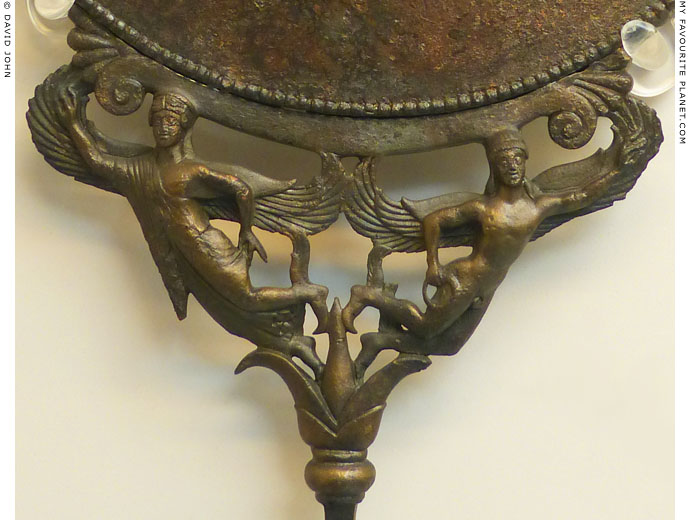
Winged Nike and Eros above the handle tang of a bronze mirror. They also have wings on their ankles.
Made in southern Italy, perhaps at Locri, around 480 BC.
British Museum. GR 1923.5-14.1. |
| |
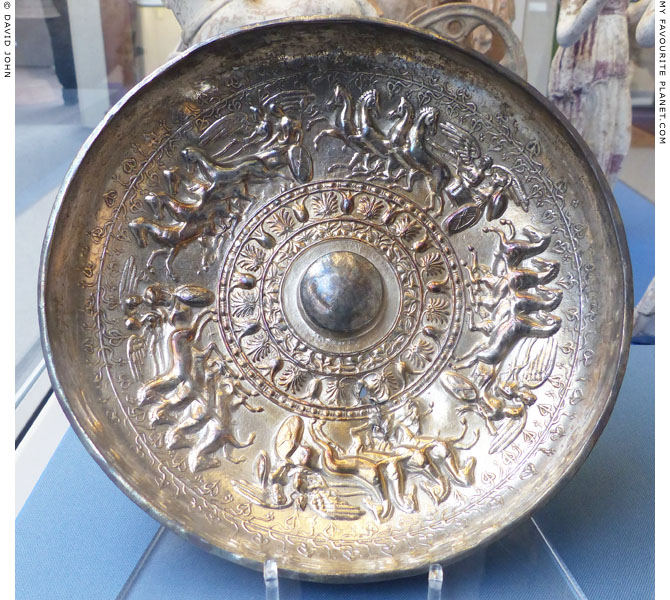
Silver phiale (φιάλη, libation bowl) with relief decoration, showing five four-horse chariots
driven by Nikai, carrying Athena, Herakles, Ares, Hermes and Dionysos. The scene represents
the apotheosis of Herakles: the hero is taken to Olympus to join the ranks of the gods.
Made in southern Italy, around 300 BC. From a hoard of Greek silver phialae,
dated to the 3rd century BC, found in the late 19th century in Èze, southern
France. Acquired in 1891 from the dealers Rollin & Feuardent.
Diameter 20.6 cm, weight 393.6 gm.
British Museum. GR 1891.6-27.3 (Silver 8). |
| |
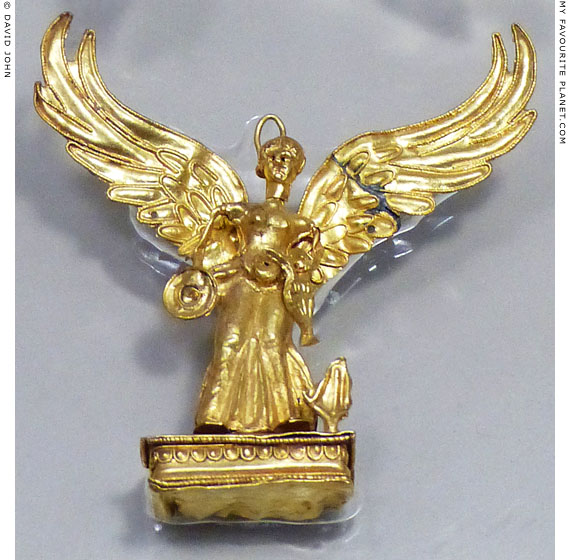
Gold pendant in the form of a winged Nike holding
a phiale (libation bowl) and and a wine jug.
Greek section, Civic Archaeological Museum, Milan. |
| |
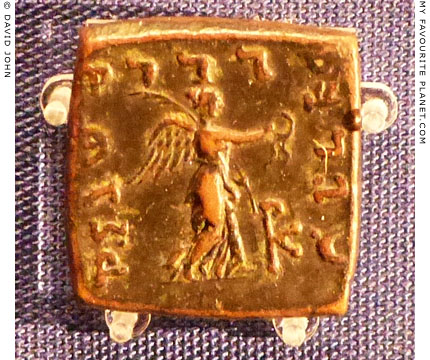
Nike on a coin of Menander (Μένανδρος), the
Greek ruler of Afghanistan-Pakistan 155-130 BC.
Ashmolean Museum, Oxford. Inv. No. HCR4605. |
| |
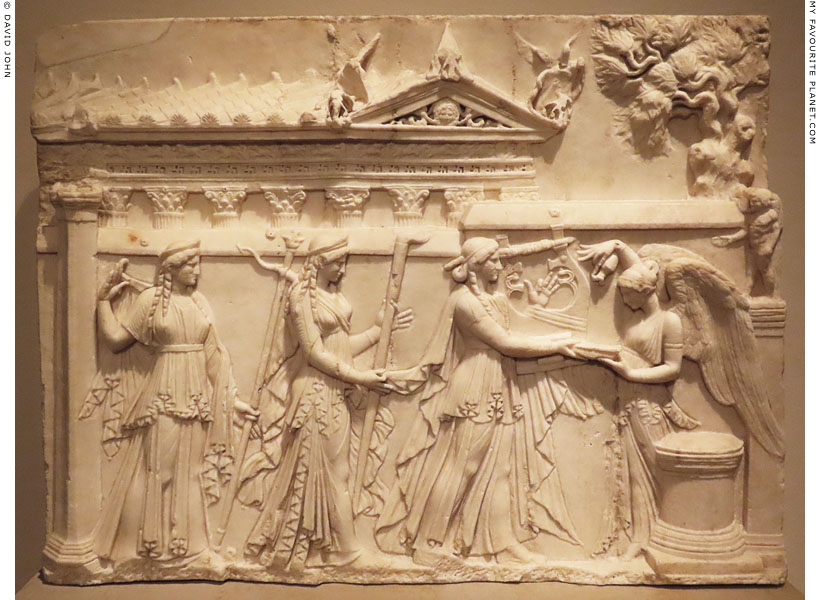
An Archaistic marble "Kitharoidos Relief" depicting Laton (Leto), Diana (Artemis) and
Apollo (sometimes refered to as the "Apollonian Triad"), walking in procession to receive
a libation from Victoria (Nike). The offering takes place in a sanctuary with a temple.
30-20 BC, Augustan period. Height 76 cm, width 98 cm, depth 12 cm.
Altes Museum, Berlin. Inv. No. Sk 921. Acquired in Rome in 1813.
|
One of seventeen similar extant reliefs and fragments, known as "Kitharoidos Reliefs" (German, Kitharödenreliefs), of which there are three types.
Findspot unknown. Confiscated by Napoleon with five other Kitharoidos Reliefs from the Villa Albani, Rome, and taken to the Louvre in 1800. During the process of restitution of looted works, it was exchanged for another confiscated relief (Paris, Louvre, Inv. MA 661) and moved to the Berliner Schloss (Royal Palace) in 1813 or 1815. It was first exhibited in the Altes Museum in 1830/1831.
On the right, winged Nike, standing next to a round altar, pours a libation from an oinochoe (wine jug) into a phiale (libation bowl) held out by Apollo with his right hand. In his left hand he holds a kithara (a large concert lyre). He is followed by his twin sister Artemis, who holds on to a hem of his garment with her right hand, and with her left hand carries a long torch. A bow hangs behind her shoulder. In the rear (left) the twins' mother Leto carries a sceptre with her left hand.
On the extreme right, behind Nike, a small statue of a nude male (perhaps Apollo), stepping forward and holding out a phiale with his right hand, stands on top of a pillar. On the far left, another taller pillar originally also supported a figure, now missing. In the background, behind a high wall, can be seen the top of a Corinthian temple, with three akroteria, two of which are apparently winged Nikai. In the centre of the pediment is a relief of a Gorgoneion (head of the Gorgon Medusa), held by two flanking winged creatures with long coiled tails. To the right of the temple is an old gnarled tree.
The iconography of the "Kitharoidos Reliefs" has been compared to those on early Augustan (late 1st century BC) sculptures, particularly Artemis and Leto on a candelabra base in the Palazzo dei Conservatori, Capitoline Museums, Rome (Inv. No. 2771) and Campana reliefs (see below and Medusa part 6) also showing Nike pouring a libation for Apollo. The background wall and temple are similar to those shown in "Ikarios reliefs" (see Dionysus). Some scholars have attempted to identify the temple in the background, offering suggestions including the Temple of Apollo in Delphi [10], and Augustus' temple of Apollo on the Palatine Hill, Rome. |
|
| |
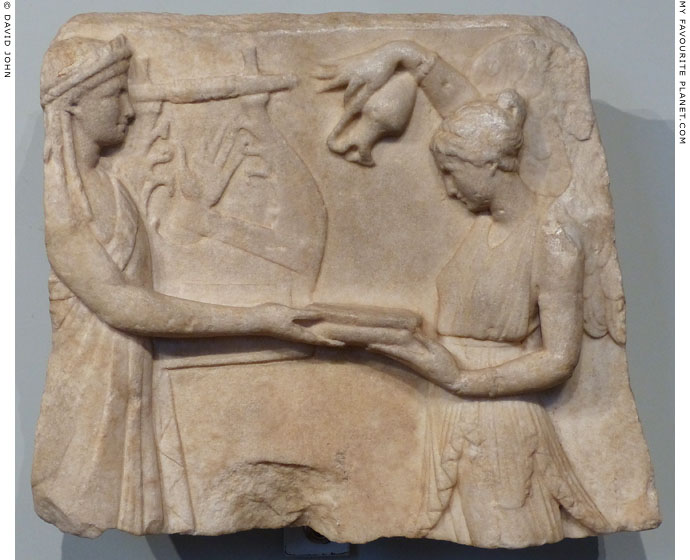
A fragment of an Archaistic "Kitharoidos Relief" (see above) showing Apollo with a lyre, holding
out a phiale (libation bowl) into which winged Nike pours a libation from an oinochoe (wine jug).
Pentelic marble. Hellenistic period.
Barracco Museum, Rome. Inv. No. MB 188. Purchased in Rome. |
| |
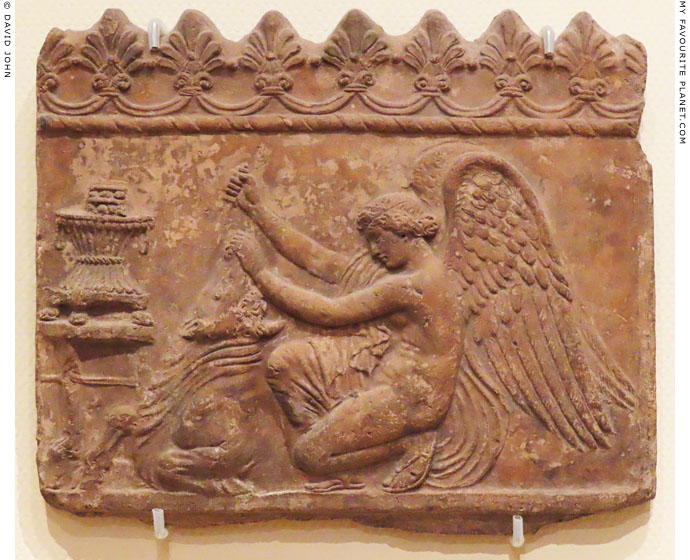
A Campana terracotta relief of Victoria sacrificing a bull.
1st century BC. From Italy.
Rijksmuseum van Oudheden, Leiden, Netherlands.
|
The winged goddess is shown naked apart from a fillet (headband), sandals and a himation (cloak), draped over her left shoulder and covering her left side and leg. She kneels over the sitting bull, and holding its snout she pulls its head into an upright position so that she can cut its throat with the dagger she holds in her raised right hand. To the left is an altar on which stands a lamp. One of a number of similar terracotta reliefs showing this scene. Another is in the British Museum (Inv. No. 1805,0703.307), and two are in the Altes Museum, Berlin (Inv. Nos. TC 558 and TC 8217.68). TC 558 appears identical to this relief.
For further information about Campana reliefs, see the note in Medusa part 6.
Variations of this scene are known from more ancient Greek depictions, for example a relief on the cover of a bronze folding mirror, 290-280 BC. National Archaeological Museum, Athens. Inv. No. 16115. |
|
| |
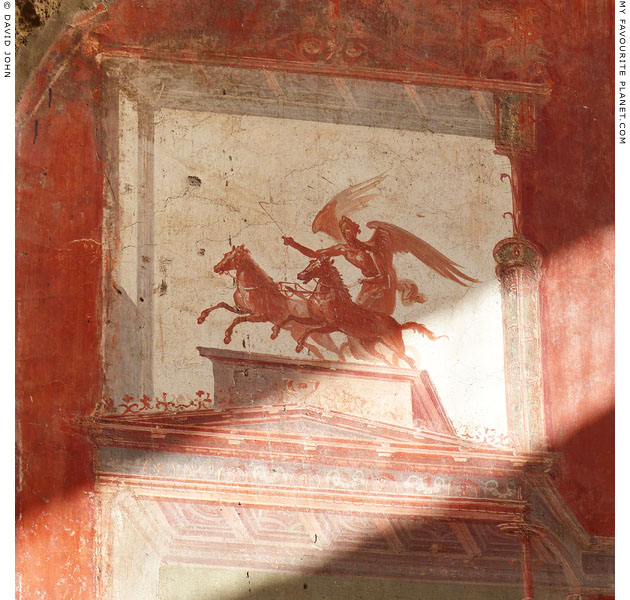
Fresco of a statue of Nike driving a two-horse chariot in
an architectural setting, above the pediment of a building.
In situ in the Sacellum of the College of the Augustales,
Insula VI, 21-24, Herculaneum Archaeological Site, Italy. |
| |
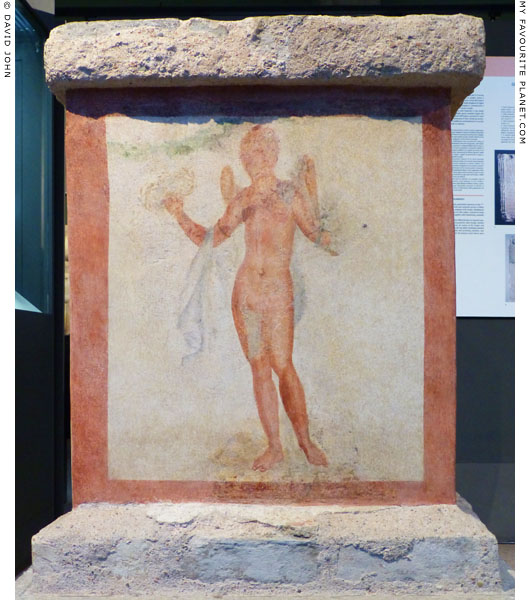
A painting of winged Victoria holding a wreath
on the side of a plaster-covered stone altar.
From the Roman city Mediolanum (Milan), late 1st - early 2nd century AD.
Found in 1825 in the Via Circo, Milan.
Probably from a domus extra moenia, outside the city walls, perhaps from a collegium
(corporation of craftsmen or merchants). Each of the four sides has a painting of a deity.
The other three sides show Tellus (Terra) or Ceres, Fortuna-Abundantia and Hercules.
Civic Archaeological Museum, Milan. Inv. No. E 0.9.1070. |
| |
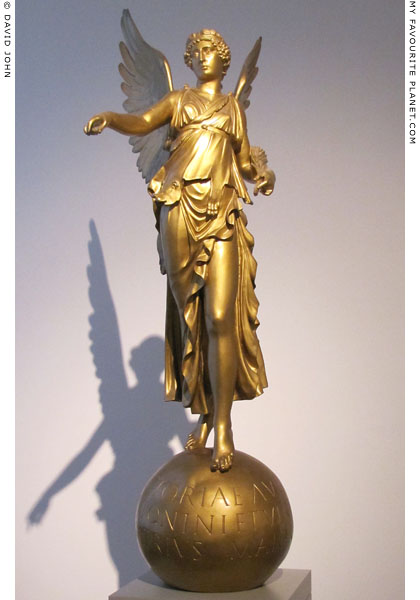 |
|
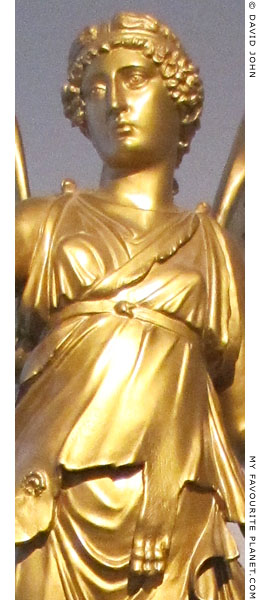 |
Victoria standing on a celestial globe, a plaster cast of the "Victoria of Calvatone",
a gilded bronze Roman statue, made around 161-165 AD. Height (including globe) 170 cm.
The original statue went missing in 1945, and was rediscovered
in 2016 in a storeroom of the Hermitage Museum, Saint Petersburg.
Altes Museum, Berlin. Until 1945 Inv. No. Sk 5.
Original from Calvatone, Italy. Acquired in 1841.
Currently Hermitage Museum, Saint Petersburg. Inv. No. ЗСсэ-574.
Plaster cast: Abguss-sammlung, Freie Universität, Berlin. Nr. 87/33. |
|
| |
The head of the original statue was found by chance in February 1836 by farm workers on the estate of Luigi Alovisi, near Calvatone (ancient Bedriacum), Cremona province, northern Italy. Alovisi encouraged local people to search for other parts, and in March they discovered three other fragments: the torso, right arm and leg, and the globe. These fragments were reassambled soon after, and the work was purchased for the Berlin State Museums in December 1841 by the German art historian Gustav Friedrich Waagen (1794-1868), director of the Berlin Gemäldegalerie (Picture Gallery). The statue was further restored in Berlin, with the addition of the missing parts: the wings, left leg, left forearm and the palm branch cradled in the left arm. It is not known whether the figure originally held a wreath in her outstretched right hand.
The plaster cast was made from the original in 1871 for the Abguss-Sammlung Antiker Plastik Berlin, and placed in the Altes Museum in 1987.
According to the inscription on the globe, the statue was commissioned by Marcus Satrius Maior to commemorate a victory of co-emperors Marcus Aurelius and Lucius Verus, probably in the Roman-Parthian War of 162-165 AD.
Victoriae Aug[ustorum]
Antonini et Veri
M[arcus] Satrius Maior
Inscription CIL 05, 04089 (= Conze 00005).
Unusually for a depiction of Victoria, she wears a nebris (νεβρίς, animal skin) normally associated with Maenads and other members of the thiasos (retinue) of Dionysus, and the pose of the lithe figure has been likened to that of depictions of dancing Maenads. The German archeologist Bruno Schröder described her animal skin as "a mixture of bear and cat, in the catalogue called a panther skin, covers the upper torso and is fastened by a belt directly beneath the breast". [11]
In 1939, at the outbreak of World War II, the original statue and other exhibits from the Berlin state museums were stored for safety in the cellar of the mint on the Molkenmark. It went missing during the final, chaotic days of the war, and was considered, like many other artworks and artefacts, to have been destroyed, looted or, more likely, taken as war booty by Soviet army trophy brigades. During the Soviet era and for some time after, information concerning war trophies was classified, and authorities usually either refused to comment on inquiries or flatly denied knowledge of artworks taken from public and private collections.
In 2016 it was announced that the statue had been found in a storeroom of the Hermitage Museum, Saint Petersburg, where it had been deposited 1946, erroneously catalogued as a 17th century French work. Although it had been on a list of artworks specifically sought by trophy brigades, when it arrived at the Hermitage, in one of 40,000 cases of plunder, it was not correctly identified or catalogued. After the war the political climate and the meagre resources available to museums made the investigation of such matters unthinkable, and the kind of research project which led to the discovery of the statue has only recently become possible. The find was first published in a journal published by the Hermitage:
A. V. Vilenskaya and A. N. Aponasenko, 'The Calvatone Victory': the fate of one artefact (in Russian), Transactions of the State Hermitage LXXIV, pages 106–113, Saint Petersburg, 2016.
The museum sent a copy of the article to the Prussian Cultural Heritage Foundation (Stiftung Preussischer Kulturbesitz) in Berlin, which led to an agreement between Hermann Parzinger, President of the foundation, and Mikhail Piotrovsky, Director of the State Hermitage, on a joint scholarly study and restoration of the sculpture. This is a positive sign of cultural cooperation between the two countries, which will hopefully lead to further research and discoveries.
Restorers at the Hermitage probed the inside of the wings, each weighing 20 kilograms, with an endoscope and discovered an engraving with the date 1844, proving that they were added in Berlin. They have now been replaced with a new, lighter pair.
The nebris, now described as a "bearskin", is still considered by some as inappropriate to a statue of Nike/Victoria, and since the wings are modern additions, it has been suggested that the statue originally depicted another deity, perhaps Diana (Artemis), more specifically Diana Lucifera (Light-Bearer). However, several depictions of Nike in this pose, standing on a globe, are known from the time of Augustus onwards, appearing on his coins, as well as on a number of Roman period artefacts, including oil lamps (see photo, right) and statuettes. The nebris may be explained as an allusion to Lucius Verus styling himself as New Dionysus (νέος Διόνυσος) and the wine god's mythical campaign in Asia (see The Triumph of Dionysus).
Following the most recent restoration, the statue was finally shown to the public for the first time in 80 years, as the centrepiece of a special exhibition in the Hermitage, "The Victoria of Calvatone: The fate of a masterpiece", 7 December 2019 - 8 March 2020. |
|
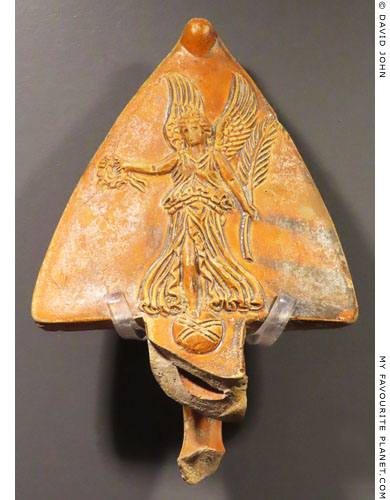
The handle of a red-slip ceramic lamp with a relief
of winged Nike standing on a globe, holding a palm
branch in her left hand and a wreath in the right.
Augustan period, 1st century BC - 1st century AD.
From the ancient city of Rhodes.
Rhodes Archaeological Museum
Currently (2022) part of the extended exhibition
"Ancient Rhodes - 2400 years" in the Palace of
the Grand Master, Rhodes.
A similar relief can be seen in the disc of
a Roman ceramic lamp in the Musée des
Beaux-Arts et d'Archéologie, Vienne, France.
A Roman bronze statuette of Victoria in this
pose, with one foot on the globe, is in the
Museo archeologico nazionale d'Abruzzo, Italy. |
|
| |
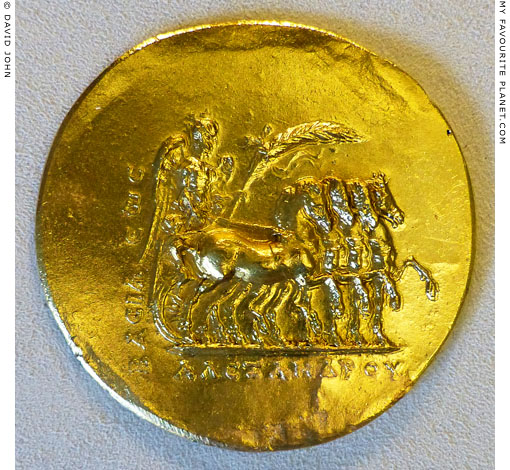
Winged Nike, driving a quadriga (four-horse chariot) to the right. She carries
a palm branch and a taenia in her left hand, and holds the reins in the right.
Inscribed to the left and beneath the quadriga:
ΒΑCΙΛΕωC ΑΛΕΞΑΝΔΡΟΥ (Basileos Alexandroy, King Alexander)
211-235 AD. On the obverse side is the head of Alexander the Great. See all
five Aboukir medallions in the Bode Museum on the Alexander the Great page.
One of twenty large gold medallions found in Aboukir, Egypt in 1902,
and now in various collections. They were minted by Roman emperors
as gifts for high-ranking officers and officials at the Alexandrian Olympic
games, held in Macedonian cities such as Veria (225-250 AD).
Bode Museum, Berlin. The original of this medallion: Inv. No. 1903/837.
Smaller scale replicas of the five Aboukir medallions in the Bode Museum
are exhibited next to the originals (with the obverse side displayed),
so that both sides of can be viewed by visitors. A good idea. |
| |
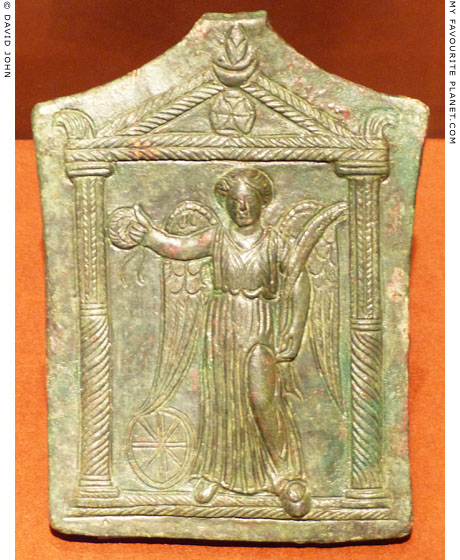
A bronze plaque in the form of a naiskos with a relief of Nike-Nemesis.
The winged goddess stands between two columns of the naiskos,
facing the front, wearing a long, high-girdled chiton (tunic). In her left
hand she holds a palm branch, and in her extended right hand she
holds a victory wreath with a fillet. Near her right foot is an eight-
spoked wheel, a symbol of Nemesis (Νέμεσις, Retribution).
From Thessaloniki. 3rd century AD.
National Archaeological Museum, Athens. Stathatos Collection. |
| |
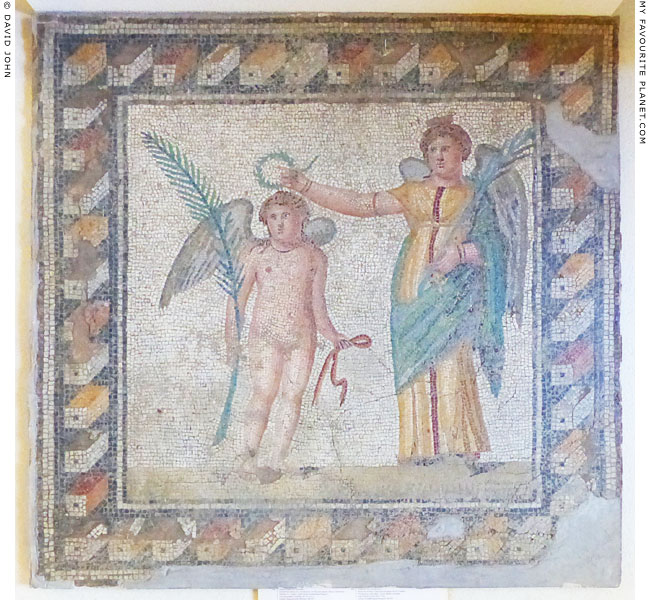
An emblema (panel) of a floor mosaic with a depiction of winged Nike crowning Eros-Agon
(Ἔρως Εναγώνιος, Eros-Enagonios, Eros-Contest), a personification of ancient Greek games,
with a kotinos (κότινος), a victor's wreath made from a branch of a sacred wild olive from
Olympia. Eros holds a victorious athlete's palm branch and purple fillet (headband).
Late Roman period, 5th century AD. From a baths complex at Kato Nero
(Καλό Νερό, Good Water), 26 km south of Larisa, Thessaly, Greece.
Larisa Archaeological Museum. Inv. No. ΜΛ/Ψ1.
Currently exhibited in the Museum of the History
of the Ancient Olympic Games, Olympia. No. 324. |
| |
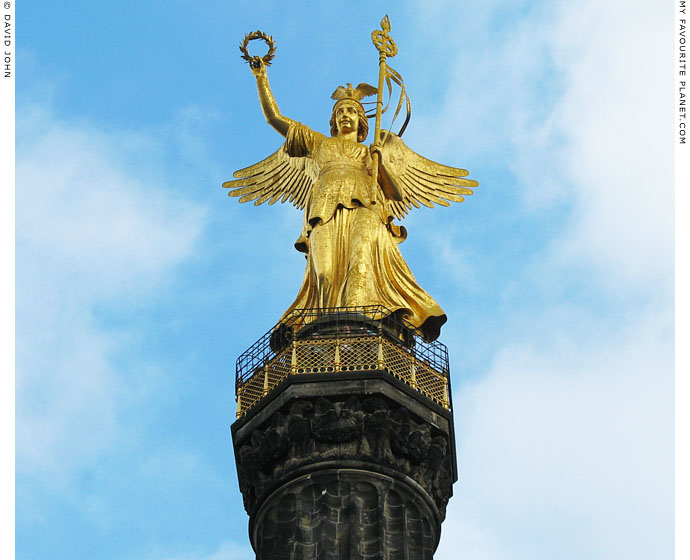
A gilded bronze statue of Victoria on top of the Siegessäule (Victory Column) in Berlin.
Made 1864-1873 by the German sculptor Friedrich Drake (1805-1882).
Cast by Hermann Gladenbeck. Height 8.30 metres, weight 35 tonnes.
|
The winged figure strides forwards confidently, holding up the laurel wreath of victory in her right hand, and a military standard with the Iron Cross in the left. She wears a helmet topped by an imperial eagle. The helmet particularly transformed the Greek goddess into Borussia, the personification of Prussia, just as in the British Empire Athena was used to represent Britannia. Berliners, with their typically disrespectful sense of humour, nicknamed the statue Goldelse (Golden Elsie), and some of the jokes about her were quite ribald.
Nike/Victoria was a clear symbol of victory in sport and war for the ancient Greeks and Romans, part of the propaganda campaigns of city states, kings and emperors, proclaiming moral and intellectual as well as physical and military superiority over their adversaries. Such symbols have been exploited by modern states since the rediscovery of ancient art during the Renaissance.
Architect Johann Heinrich Strack (1805-1880) was commissioned to design the Siegessäule monument, originally to commemorate the Prussian victory over Denmark in 1864. However, further victories of Prussian-led German armies over Austria in 1866 and France in 1871, meant that the original design had to be modified in order to include references to these later conflicts. The so-called "unification wars" were provoked by Prussian Minister President Otto von Bismarck as part of his plan to create a united German Empire under Wilhelm I, with himself as Chancellor.
At the base of the 66.89 metre high monument (originally 60.5 metres) is a massive four-sided entrance hall of polished red granite, the outer walls of which are decorated with large bronze reliefs illustrating episodes from the wars, very much in the way the Greeks and Romans decorated their sacred and secular buildings and columns with scenes of historical and mythical battles. Above the hall, around the column base, the wall within a circular colonnade (another classical form) is decorated with an enormous glass mosaic designed by Anton von Werner. From the colonnade a spiral stairway of 285 steps inside the fluted sandstone column leads up to an observation platform beneath the statue. Around the outside of the column hang gilded cannon barrels, booty from the three wars, again echoing the ancient tradition of displaying the arms of defeated enemies on monuments (see for example the "Monument of Shields" in Dion, Macedonia).
The choice of a monumental column for a war memorial was influenced Roman victory columns, such as those of emperors Trajan, Marcus Aurelius, Antoninus Pius and Phocas, which had been admired by northern Europeans visiting Rome. Similar victory columns were erected around Europe during the 19th century, notably Nelson's Column in London.
Prussia's eagle (in German, Adler) was a symbol of the Hohenzollern dynasty's chivalric past, their place in the Holy Roman Empire (from 1512 the Holy Roman Empire of the German Nation), and eventually their claim to imperial supremacy. The eagle, originally associated with the supreme Greek god Zeus and his Roman conterpart Jupiter, became the symbol in turn of the Roman Republic, the Roman Empire and the Christian Holy Roman Empire. With the addition of the swastika it served the Nazi Third Reich (Third Empire), and without it remains the symbol of modern German Federal Republic.
Originally the monument stood on Königsplatz (King's Square, now Platz der Republik), at the end of the Siegesallee (Victory Avenue), between the Brandenburg Gate and the Reichstag parliament building. As part of the meglomanic plans of Adolf Hitler and his architect Albert Speer to rebuild Berlin as the Nazi world capital Germania, in 1938-1939 it was moved 1.6 km westwards to its present location in Tiergarten. It now stands in the centre of an enormous traffic roundabout, the Großer Stern (Great Star), at the junction of major arterial roads, which is surrounded by other Prussian monuments such as the colossal statue of Bismark. The roundabout is accessed by four underground pedestrian tunnels, designed by Speer and built in 1941.
Surprisingly, the column survived British and American aerial bombing as well as Russian artillery bombardment of the city during World War II. It was restored in 1954 when the statue was regilded by the Hermann Noack foundry, and was further restored in 1989 und 2011. |
|
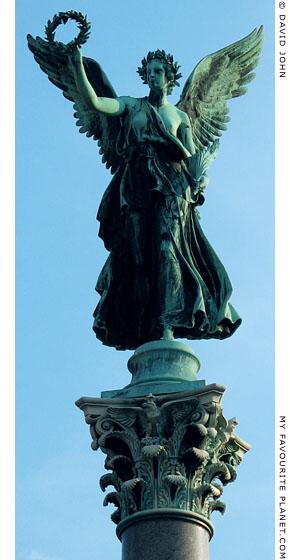
The Friedenssäule (Peace Column),
an earlier, smaller Prussian bronze
statue of winged Victoria holding a
laurel leaf and a palm brach, on a
19 metre high granite column with a
Corinthian capital of Carrera marble,
decorated with Prussian eagles.
Mehringplatz, Kreuzberg, Berlin.
Commissioned by Prussian king
Friedrich Wilhelm III to commemorate
the allied victory over Napoleon in 1813,
the monument was designed by stone-
mason and builder Christian Gottlieb
Cantian (1794-1866) and erected in
1843. The statue was designed by
Christian Daniel Rauch (1777-1857),
after an ancient bronze original
discovered in Pompeii in 1823. Friedrich
Drake, who designed the Siegessäule
Victoria, had been a student of Rauch. |
|
| |
| Nike |
Notes, references and links |
 |
|
1. Hesiod on Nike's family, Zeus and the Gigantomachy
"And Styx the daughter of Ocean [Okeanos] was joined to Pallas and bore Zelus (Emulation) and trim-ankled Nike (Victory) in the house. Also she brought forth Cratos (Strength) and Bia (Force), wonderful children. These have no house apart from Zeus, nor any dwelling nor path except that wherein God leads them, but they dwell always with Zeus the loud-thunderer.
For so did Styx the deathless daughter of Ocean plan on that day when the Olympian Lightener called all the deathless gods to great Olympus, and said that whosoever of the gods would fight with him against the Titans, he would not cast him out from his rights, but each should have the office which he had before amongst the deathless gods. And he declared that he who was without office and rights under Cronos, should be raised to both office and rights as is just.
So deathless Styx came first to Olympus with her children through the wit of her dear father. And Zeus honoured her, and gave her very great gifts, for her he appointed to be the great oath of the gods, and her children to live with him always. And as he promised, so he performed fully unto them all. But he himself mightily reigns and rules."
Hesiod (8th - 7th century BC), Theogony, lines 383-403. In: The Homeric Hymns and Homerica. English translation by Hugh G. Evelyn-White. Loeb Classical Library edition, LCL 57. Harvard University Press, Cambridge, Massachusetts. and William Heinemann Ltd., London, 1914. At Perseus Digital Library.
2. Nike as daughter of Ares
It could be argued that Ares is being described poetically and symbolically as the father of victory in war rather than literally as the father of the goddess Nike.
"Ares, exceeding in strength, chariot-rider, golden-helmed, doughty in heart, shield-bearer, Saviour of cities, harnessed in bronze, strong of arm, unwearying, mighty with the spear, O defence of Olympus, father of warlike Victory, ally of Themis, stern governor of the rebellious, leader of righteous men, sceptred King of manliness, who whirl your fiery sphere among the planets in their sevenfold courses through the aether wherein your blazing steeds ever bear you above the third firmament of heaven; hear me, helper of men, giver of dauntless youth! Shed down a kindly ray from above upon my life, and strength of war, that I may be able to drive away bitter cowardice from my head and crush down the deceitful impulses of my soul. Restrain also the keen fury of my heart which provokes me to tread the ways of blood-curdling strife. Rather, O blessed one, give you me boldness to abide within the harmless laws of peace, avoiding strife and hatred and the violent fiends of death."
Homeric Hymn VIII To Ares. In: The Homeric Hymns and Homerica. English translation by Hugh G. Evelyn-White. Loeb Classical Library edition, LCL 57. Harvard University Press, Cambridge, Massachusetts. and William Heinemann Ltd., London, 1914. At Project Gutenberg.
3. Nike as judge
"Nike, giver of sweetness, to you the father, son of Ouranos, on his high bench has granted glorious honour, so that in gold-rich Olympos you stand beside Zeus and judge the outcome of prowess for immortals and mortals: be gracious, daughter of thick-tressed, right-judging Styx; it is thanks to you that Metapontion ... is now filled with the celebrations and festivities of strong-limbed youths, and they sing the praises of the Pythian victor."
Bacchylides (Greek lyric poet, 5th century BC), "For Alexidamus of Metapontion, victor in the boys' wrestling match at Pytho (Delphi)". Ode X, Fragment 11, British Museum Papyrus 733.
See:
David A. Campbell, Greek lyric poetry: a selection of early Greek lyric, elegiac and iambic poetry. Bristol Classical Press, 1982.
J. M. Edmonds, Lyra Graeca Volume III, Book VII: Victory songs, 38 (X), pages 174-185. The Loeb Classical Library. William Heinemann, London; G. P. Putman's Son, New York, 1927.
Richard Claverhouse Jebb, Bacchylides: The Poems and Fragments, Ode X (XI), pages 208-212 and 321-335. Cambridge University Press, 1905.
4. Pauanias on Nike Apteros
Pauanias, describing the entrance to the Athens Acropolis, wrote:
"On the right of the gateway [Propylaia] is a temple of Wingless Victory."
Pausanias, Description of Greece, Book I, Chapter 22, section 4. At Perseus Digital Library.
Later, he comapres a cult figure of Enyalius [Ares] in Chains in Sparta, with the Wingless Nike in Athens:
"Near is a temple of Hipposthenes ... Opposite this temple is an old image of Enyalius [Ares] in fetters. The idea the Lacedaemonians express by this image is the same as the Athenians express by their Wingless Victory; the former think that Enyalius will never run away from them, being bound in the fetters, while the Athenians think that Victory, having no wings, will always remain where she is."
Pausanias, Description of Greece, Book 3, Chapter 15, sections 7-8. At Perseus Digital Library.
5. Nike in the Souda
The Suda or Souda (Σοῦδα), a Byzantine encyclopaedia of the ancient Mediterranean world, written in the 10th century AD.
See: Suda On-Line
Heliodoros the Periegete, Heliodoros Periegetes, also known as Heliodorus of Athens (Ηλιόδωρος, Heliodoros, Gift of the Sun), a 2nd century BC Athenian author, thought to have written fifteen books on the Athens Acropolis around 150 BC. His works, now lost, were used as a source by several ancient authors, including Pliny the Elder and possibly Plutarch.
6. Nike on a black-figure amphora from Amathus, Cyprus
Arthur H. Smith (1860-1941), Excavations at Amathus. In Alexander S. Murray, Arthur H. Smith, Henry Beauchamp Walters, Excavations in Cyprus, pages 87-126, plates IV and XIV. British Museum, London, 1900. At Heidelberg University Library.
Description of the amphora on page 110, figs. 161 and 162.
7. The Nike akroterion from the Athens Agora
The statue was found in front of the Stoa of Zeus Eleutherios, and the American archaeologist Homer A. Thompson believed it stood on the south wing of building. Later the archaeologist Evelyn B. Harrison (who also worked at the Agora for many years) considered that it was proportionately too large for the stoa, and suggested that it may have been a corner akroterion from the Doric hexastyle peripteral temple of Ares, which had been moved block by block to a different location in the Agora in Antiquity. Although she admitted that there was insufficient archaeological evidence concerning the temple's roof to be certain, she noted that the statue's support had been rechiselled during the Roman period. The figure's wings may also have been repaired at this time.
See: Evelyn B. Harrison, Repair, reuse, and reworking of ancient Greek sculpture. In: Marion True and Jerry Podany (editors), Marble: Art historical and scientific perspective on ancient sculpture, Papers delivered at a symposium organized by the Departments of Antiquities and Antiquities Conservation and held at the J. Paul Getty Museum, April 28-30, 1988, pages 163-184 (particularly pages 176-179). J. Paul Getty Museum, Malibu, California, 1990.
8. The Assinaria festival in Syracuse
The final defeat of the Athenians by the Syracusans and Spartans at the river Assinaros was described by Thucydides and Diodorus Siculus:
Thucydides, The Peloponnesian War, Book 7, chapters 84-85. At Perseus Digital Library.
Diodorus Siculus, Historical Library, Book 13, chapter 19. At Perseus Digital Library.
Plutarch related that the general assembly of the Syracusans voted to name the commemorative religious festival after the river. He does not mention games as part of the festival, and their existence has been questioned by some scholars.
Plutarch, Parallel Lives, Nicias, chapters 27-28. At Perseus Digital Library.
9. Ancient coins in the Civic Archaeological Museum, Milan
Only a small number of ancient coins from Milan's enormous publicly-owned numismatic collection are displayed in the archaeological Museum. Most of the estimated 300,000 items from the state and municipal collections are kept in the archaeological and numismatic libraries in the Castello Sforzesco. The coins above are numbered according to the catalogue of the Numismatic Cabinet of Brera (Gabinetto numismatico), in the Palazzo di Brera, which housed much of the collection 1808-1917.
10. Kitharoidos Relief and Delphi
The suggestion was first made in two articles by Franz Studniczka, in: Jahrbuch des Kaiserlich Deutschen Archäologischen Instituts, Band 21 (1906), pages 77 ff., and Band 22 (1907), pages 6-8. Georg Reimer, Berlin, 1907 and 1908.
Studniczka was aware that the Doric architecture of the temple at Delphi did not match the Corinthian style building shown on the reliefs. As part of his argument for a Delphic setting, Studniczka also suggested that the small statue on the pillar may have been the dedication of Echecratides (Ἐχεκρατίδης) mentioned by Pausanias as the earliest dedication set up in the Delphi sanctuary:
"Echecratides of Larisa dedicated the small Apollo, said by the Delphians to have been the very first offering to be set up."
Pausanias, Description of Greece, Book 10, chapter 16, section 8. At Perseus Digital Library.
11. The Victoria of Calvatone nebris
"Ein Fell, ein Gemisch von Bär und Katze, im Katalog als Pantherfell bezeichnet, bedeckt den Oberkörper und wird von einem Gürtel dicht unter der Brust zusammengehalten."
("An animal skin, a mixture of bear and cat, in the catalogue called a panther skin, covers the upper torso and is fastened by a belt directly beneath the breast.")
Bruno Schröder (1878-1934), Die Victoria von Calvatone, page 6. Programm zum Winckelmannsfeste der Archäologischen Gesellschaft zu Berlin (Band 67). Georg Reimer, Berlin, 1907. |
|
|
| |
Photos on this page were taken during
visits to the following museums:
Germany
Berlin, Altes Museum
Berlin, Bode Museum
Berlin, Pergamon Museum
Greece
Amphipolis Archaeological Museum
Athens, Acropolis Museum
Athens, Agora Museum
Athens, National Archaeological Museum
Corinth Archaeological Museum
Delphi Archaeological Museum
Dion Archaeological Museum, Macedonia
Olympia, Museum of the History of the Ancient Olympic Games
Rhodes Archaeological Museum
Samothraki Archaeological Museum, Thrace
Thasos Archaeological Museum, Macedonia
Thebes Archaeological Museum
Italy
Herculaneum Archaeological Site
Milan, Civic Archaeological Museum
Ostia Archaeological Museum
Paestum, National Archaeological Museum
Rome, Barracco Museum
Italy - Sicily
Agrigento Regional Archaeological Museum
Palermo, Antonino Salinas Regional Archaeological Museum
Netherlands
Leiden, Rijksmuseum van Oudheden
Turkey
Bergama Archaeological Museum
Ephesus archaeological site
Istanbul Archaeological Museums
United Kingdom
London, British Museum
Oxford, Ashmolean Museum
Many thanks to the staff of these museums. |
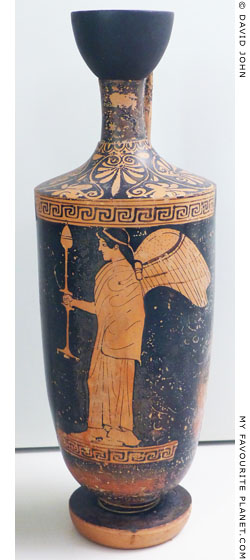
Red-figure lekythos with
a depiction of winged Nike.
Attributed to the Nikon Painter.
Mid 5th century BC. From
Akragas (Agrigento), Sicily.
Antonino Salinas Regional
Archaeological Museum, Palermo. |
|
| Photos and articles © David John, except where otherwise specified. |
 |
Visit the My Favourite Planet Group on Facebook.
Join the group, write a message or comment,
post photos and videos, start a discussion... |
|
|
| |
| Copyright © 2003-2025 My Favourite Planet | contributors | impressum | contents | sitemap |
| |
























































































